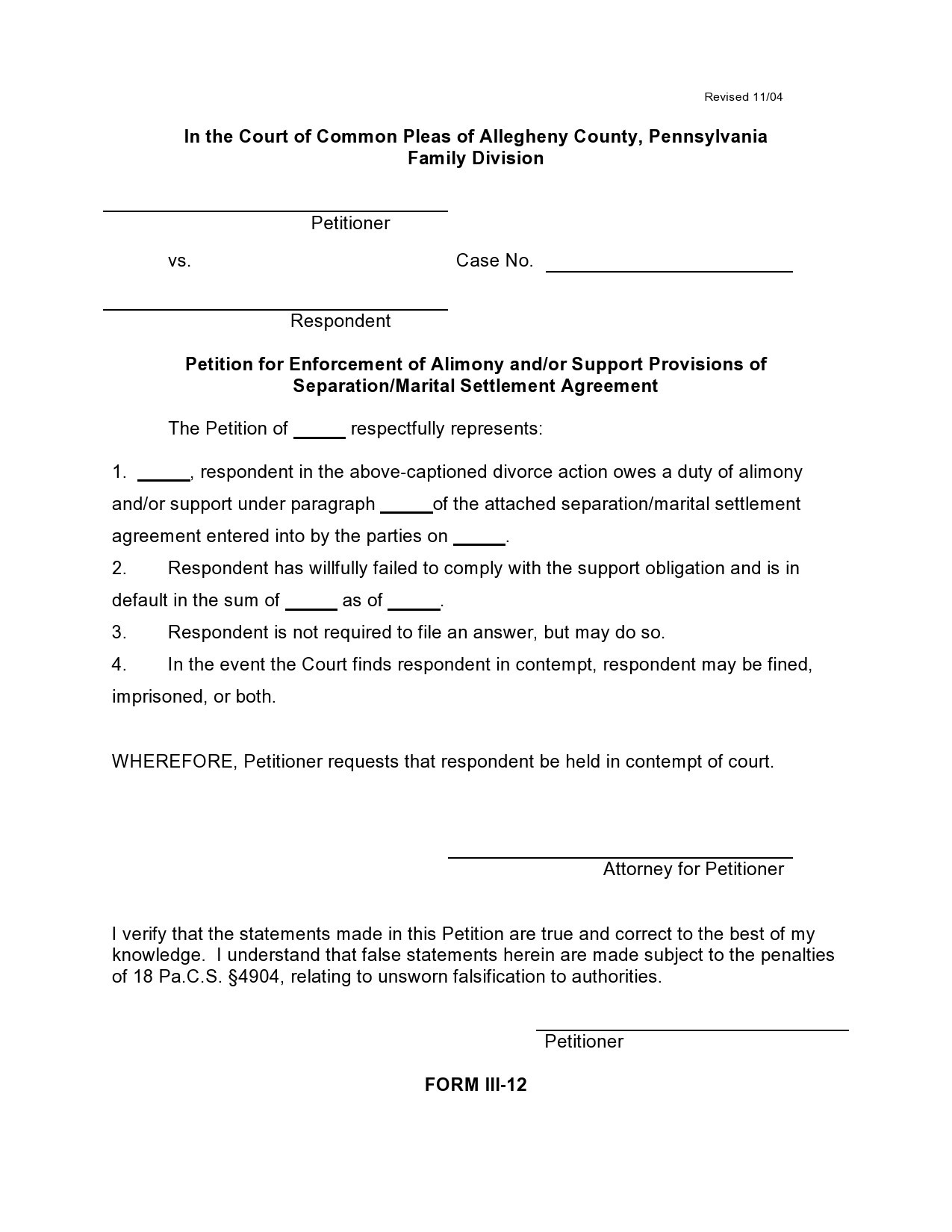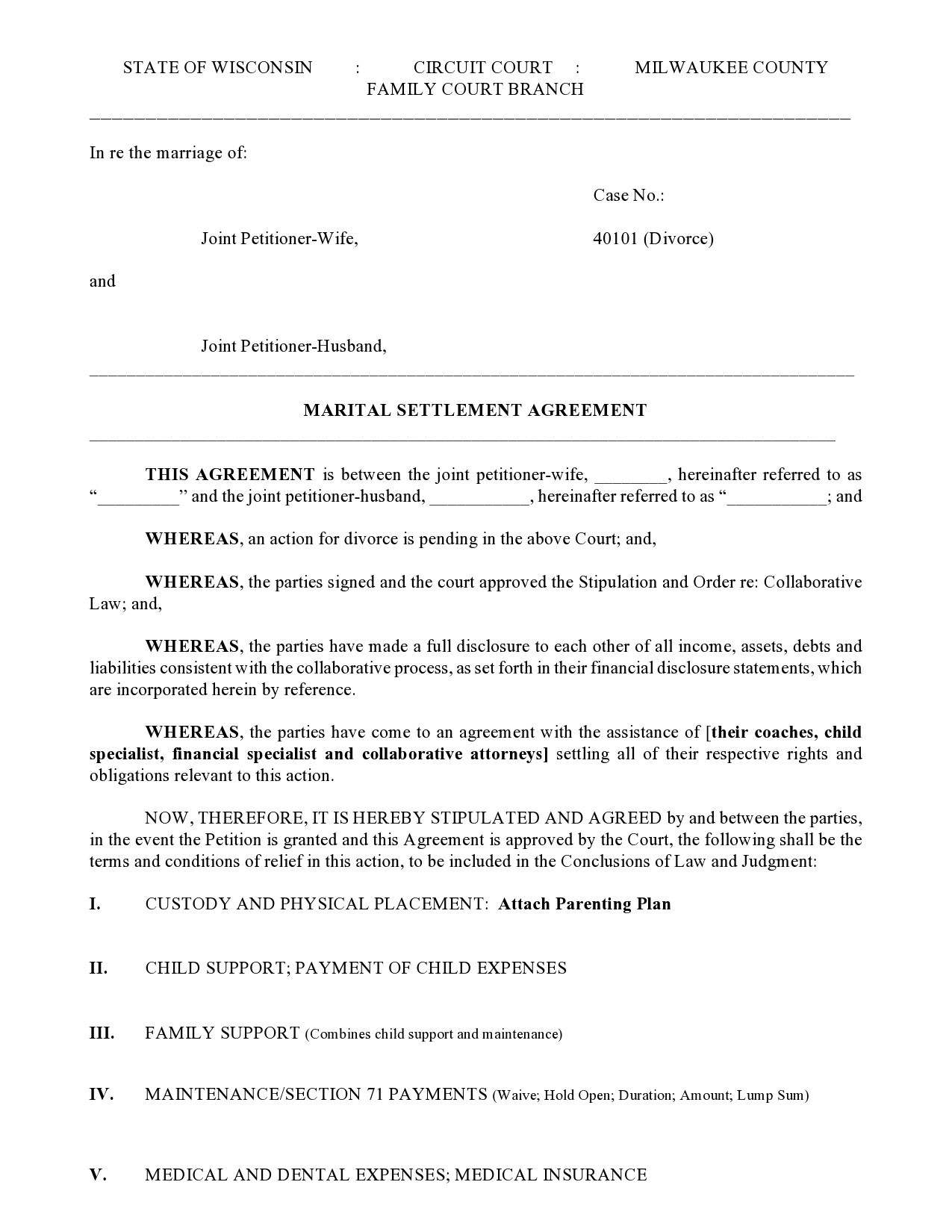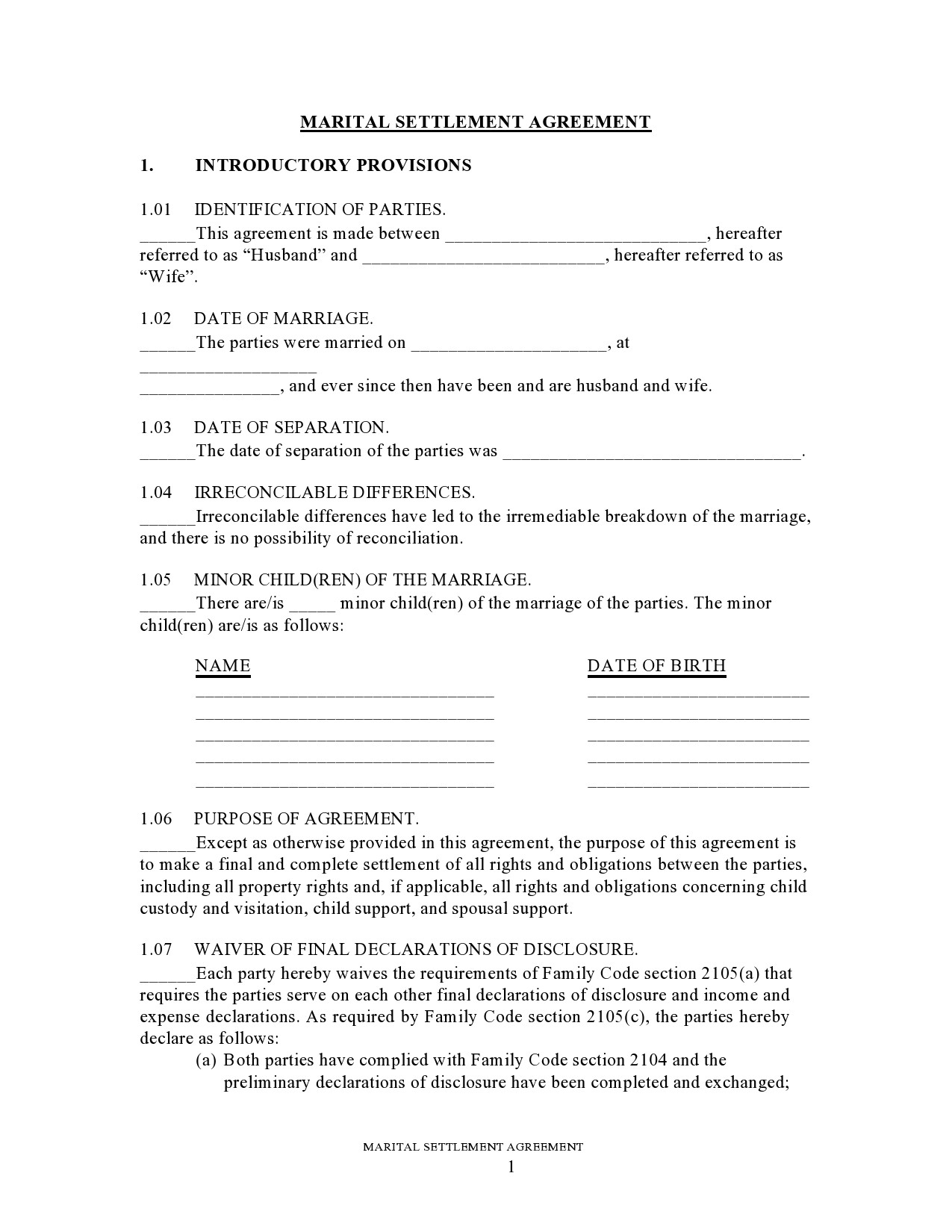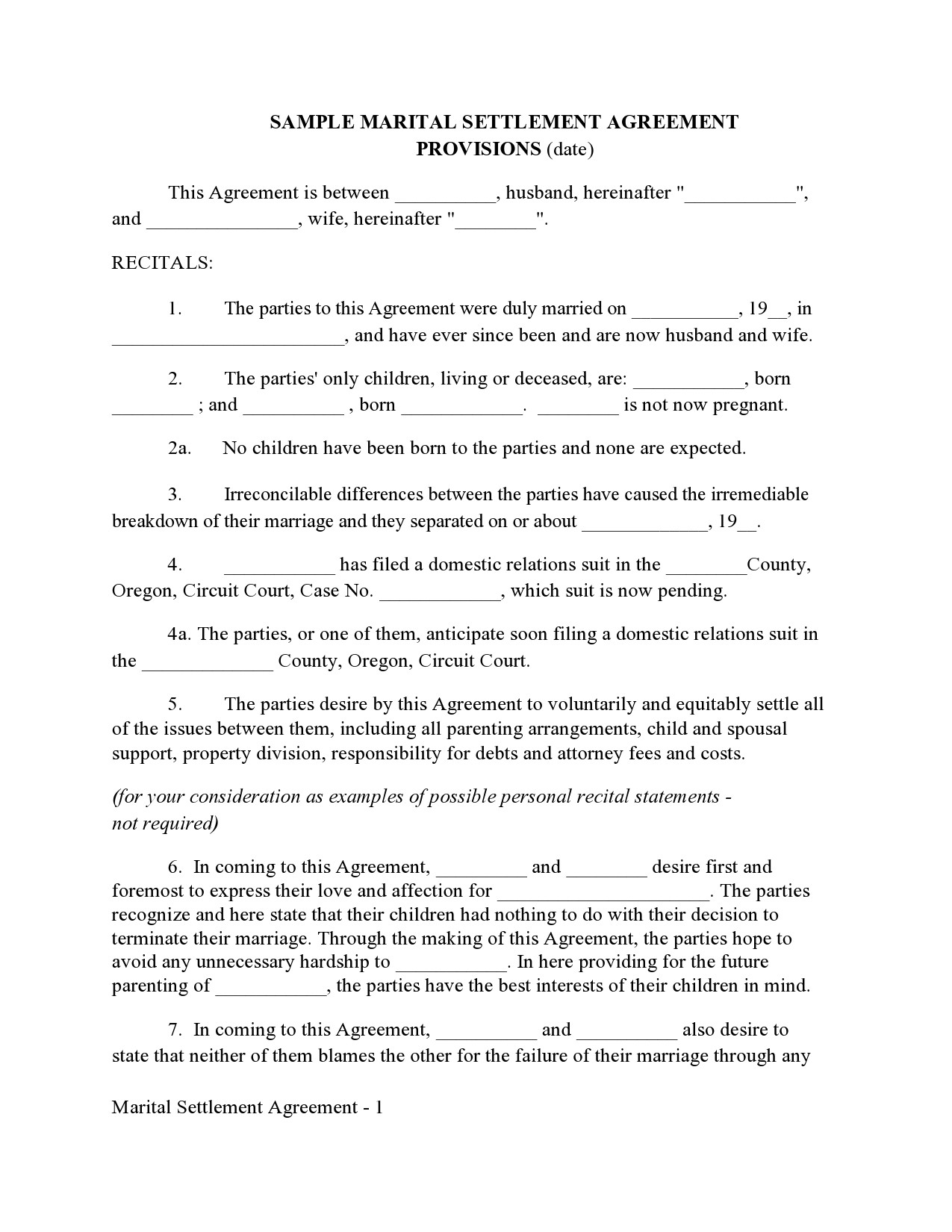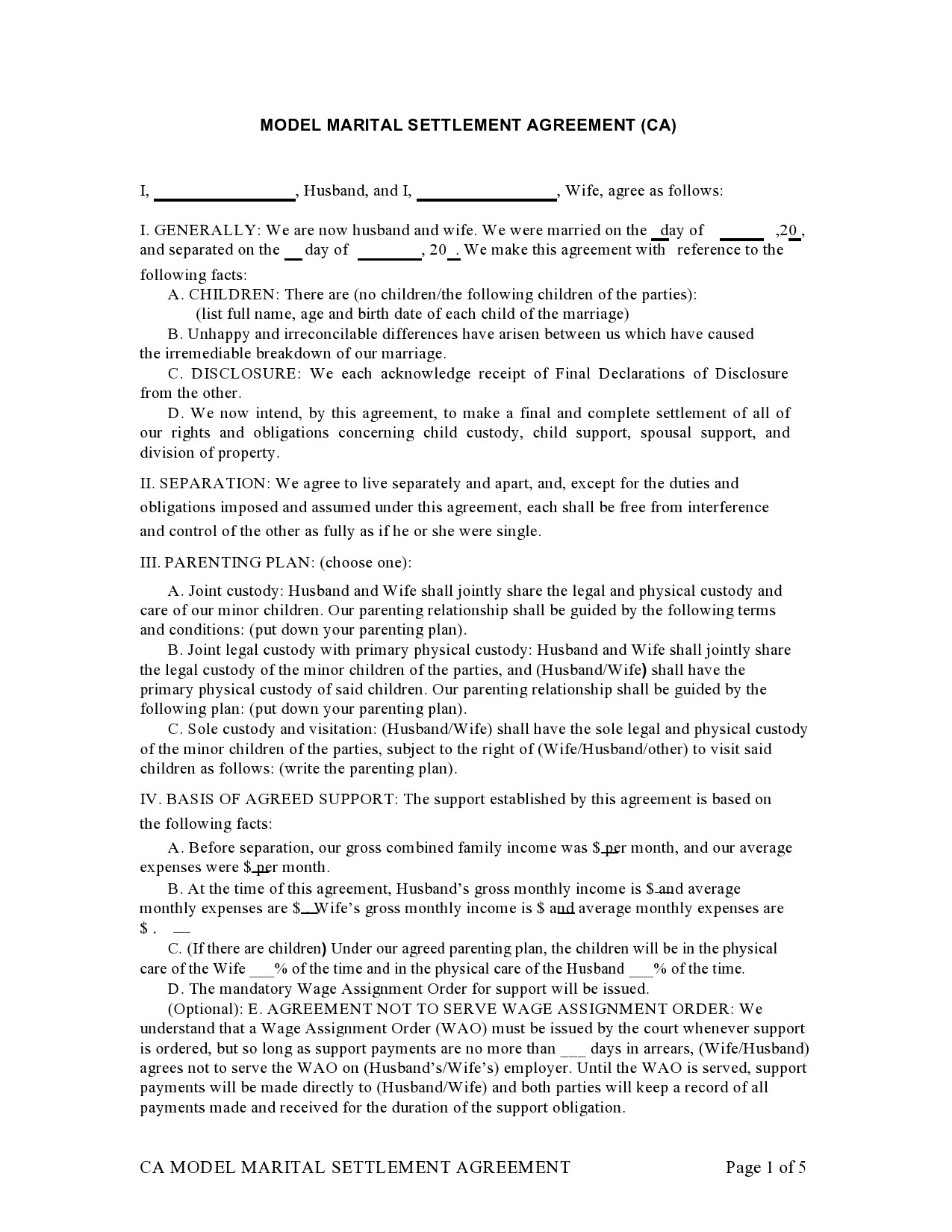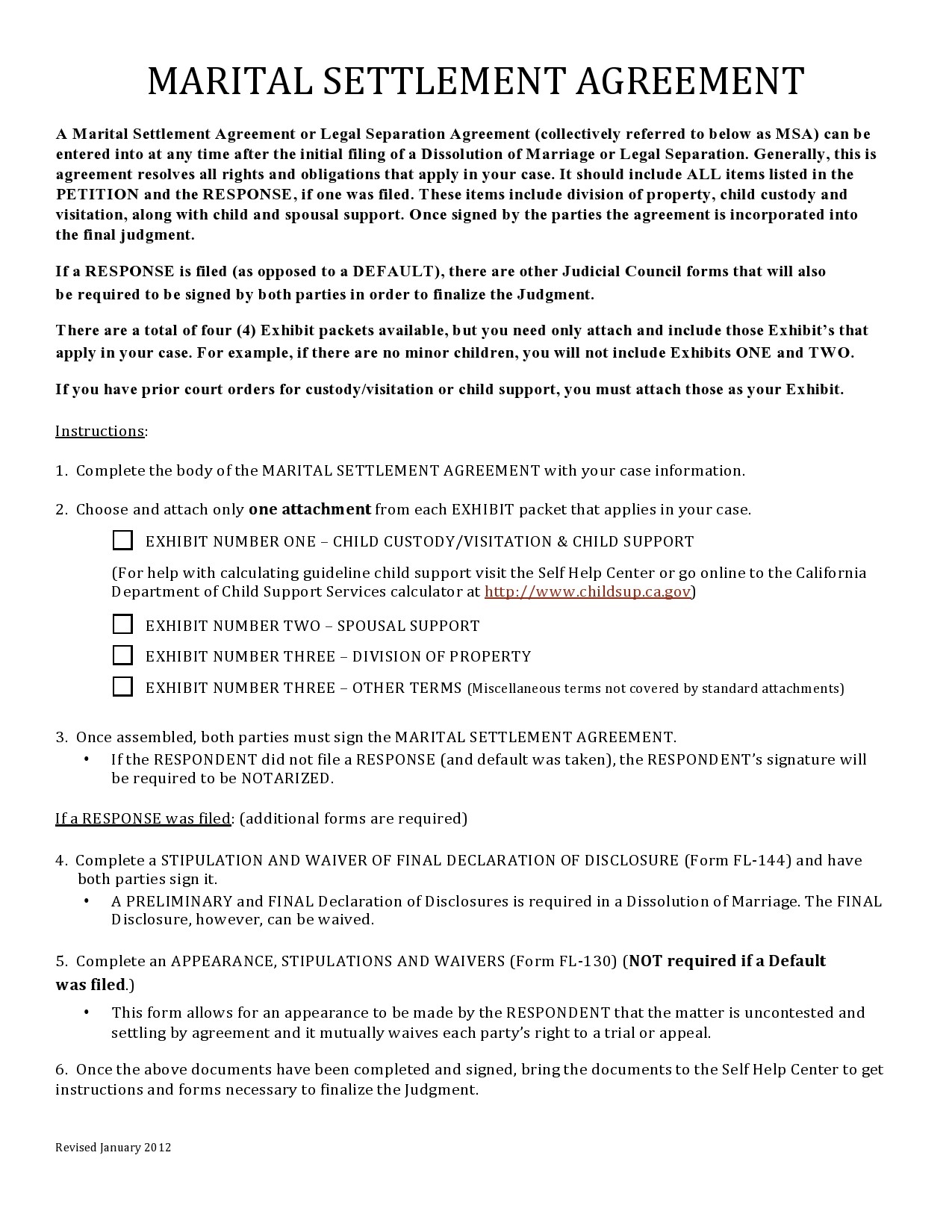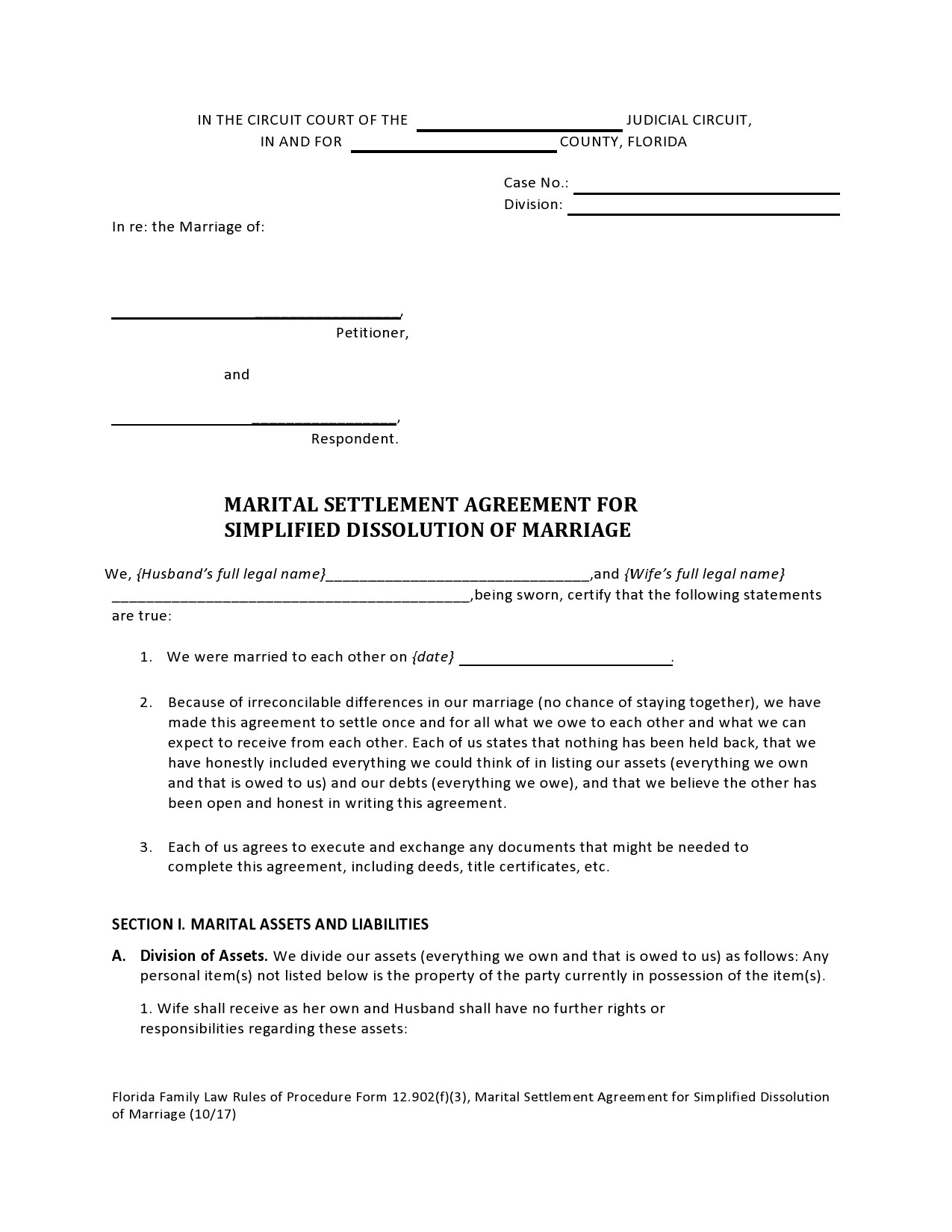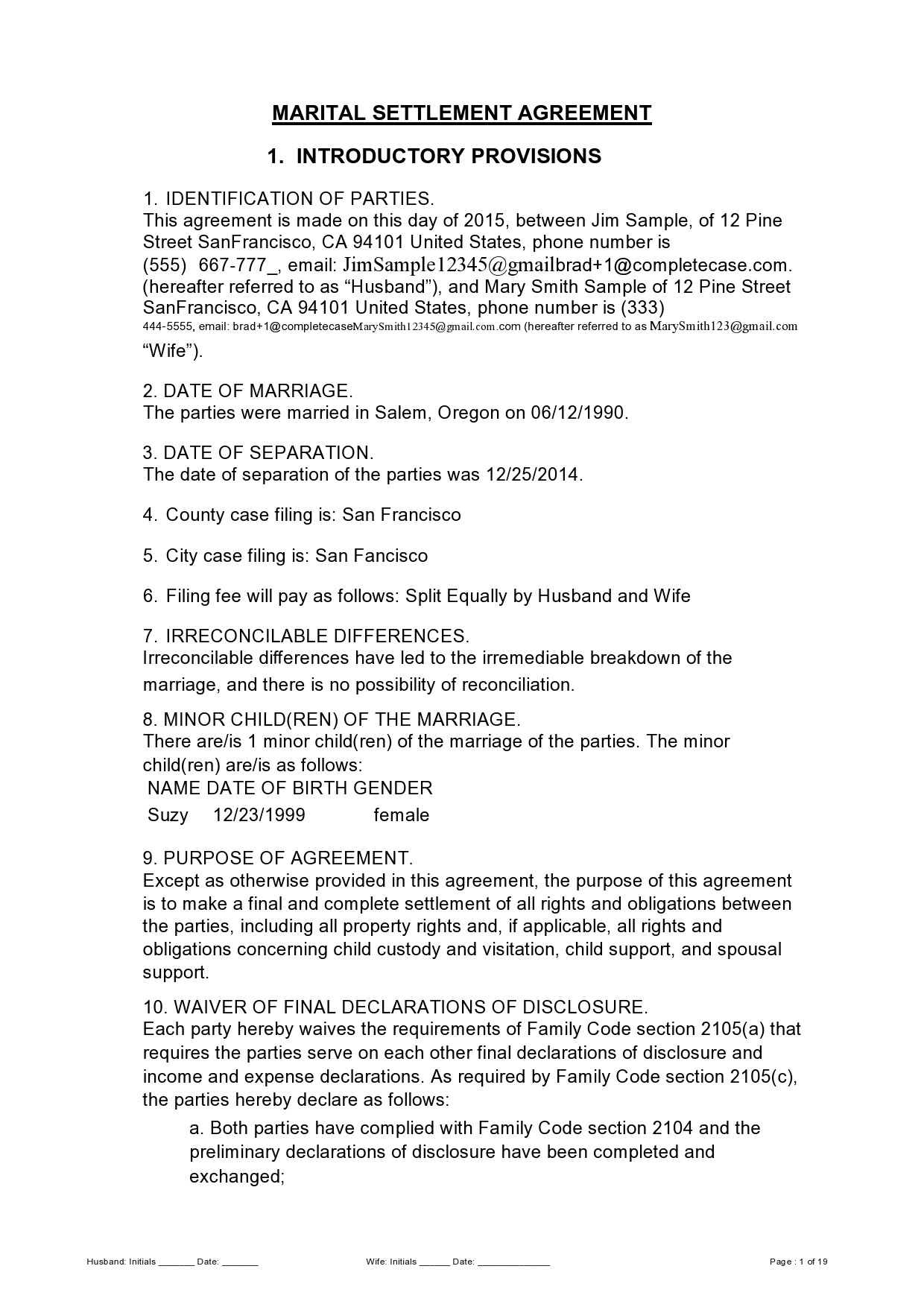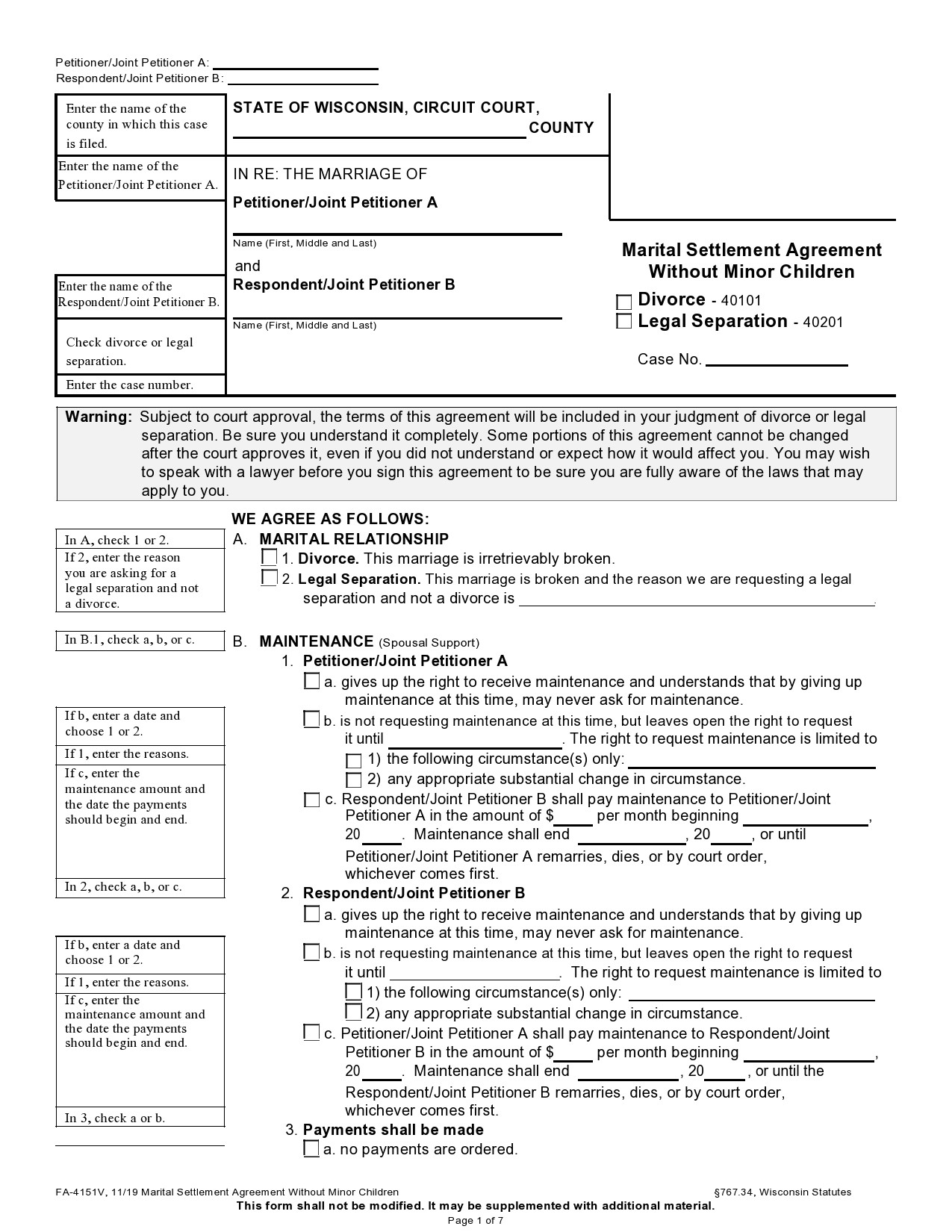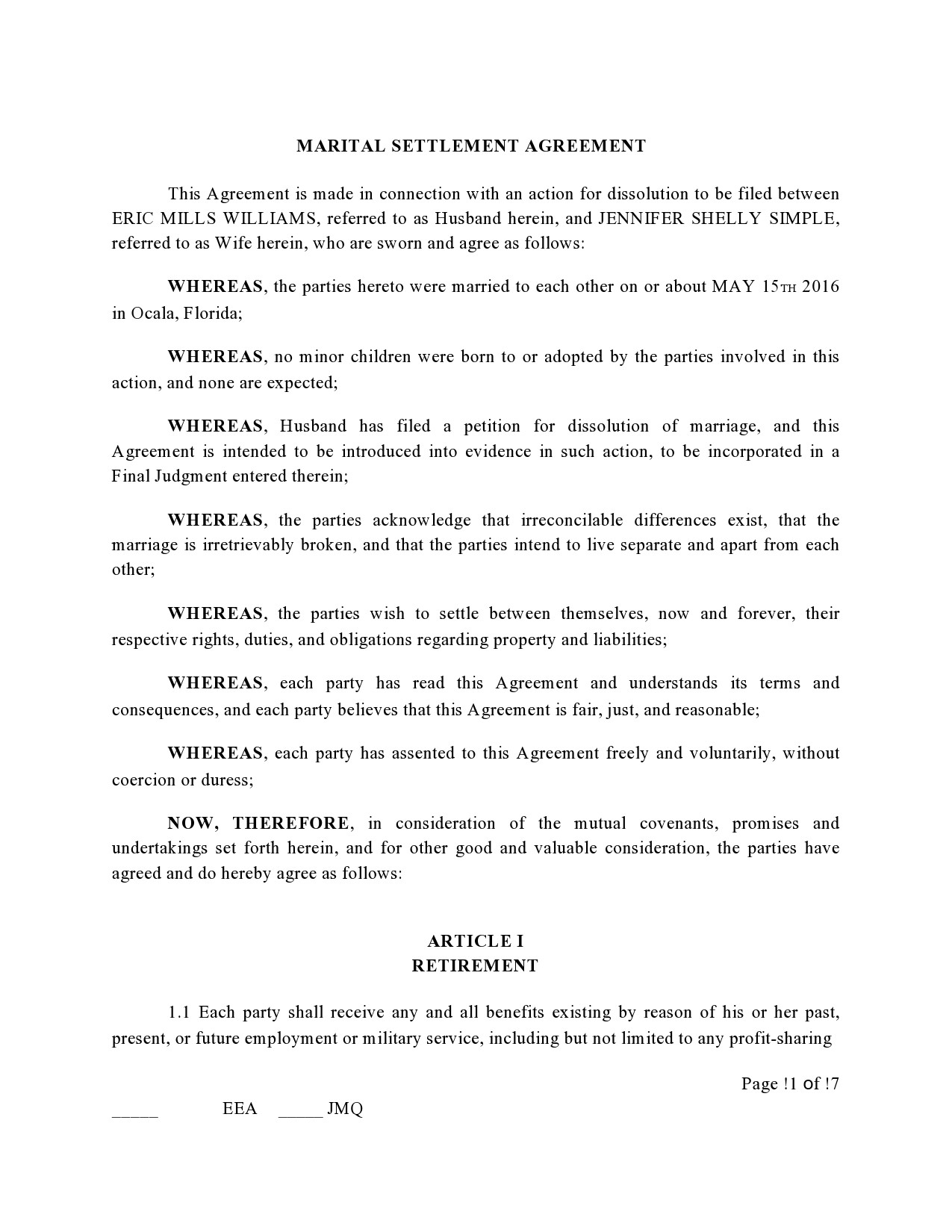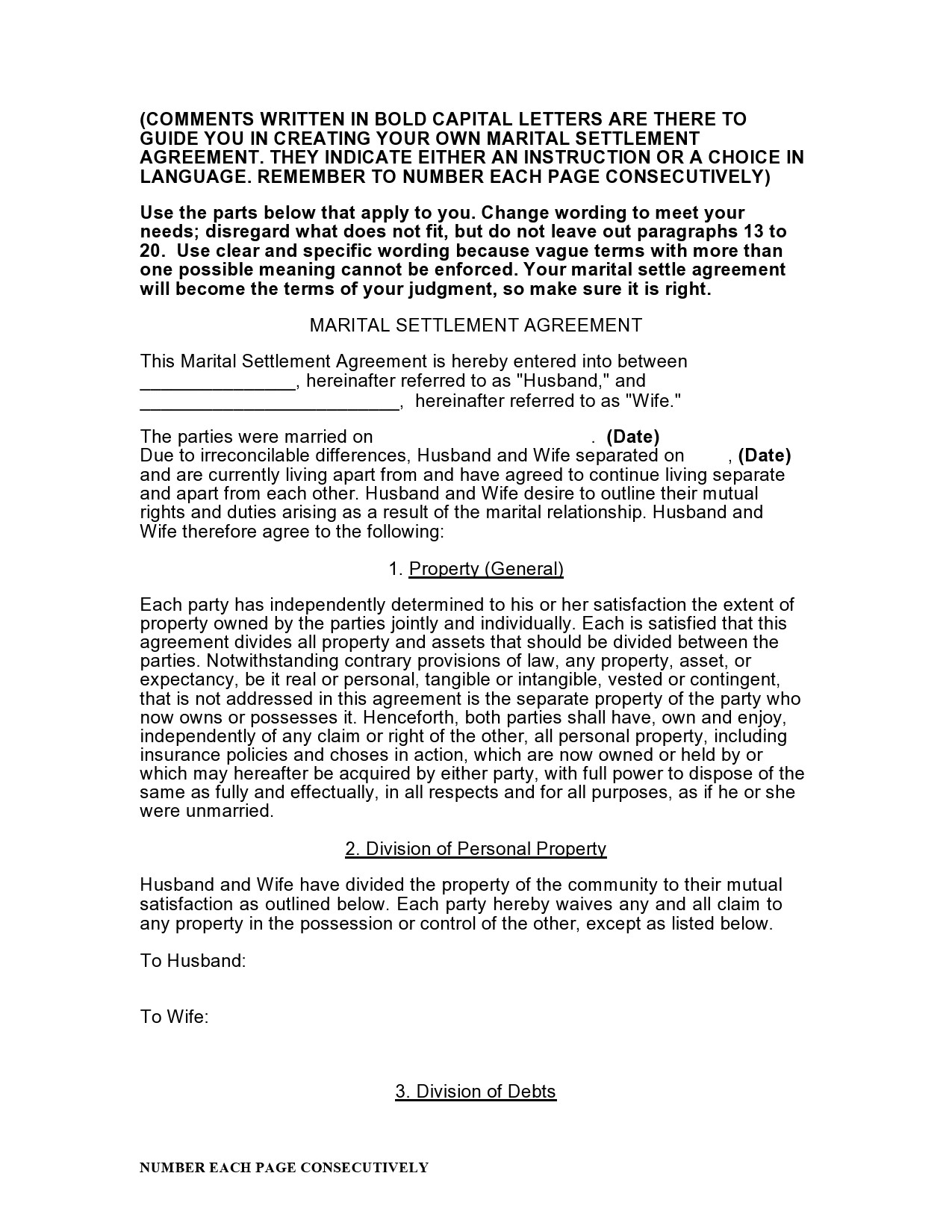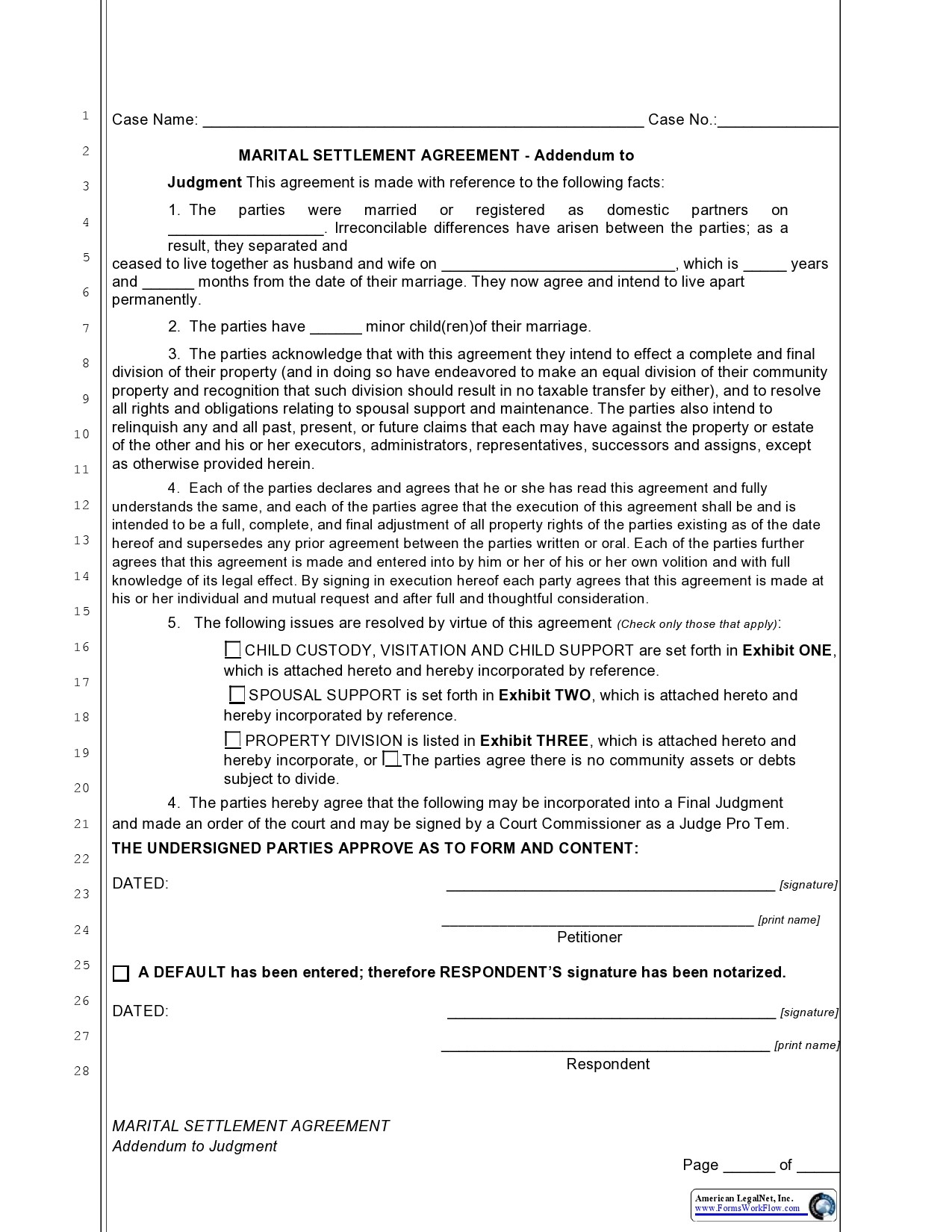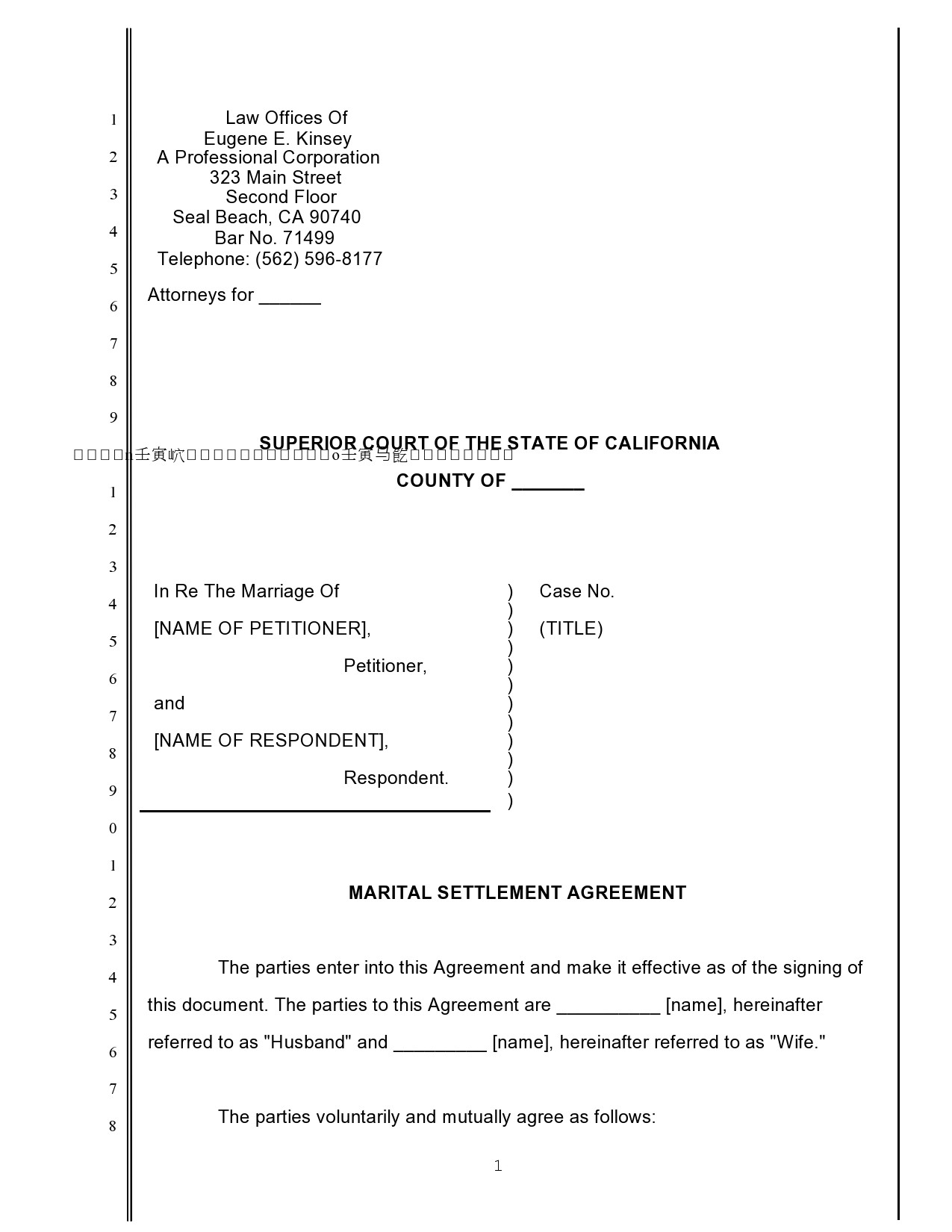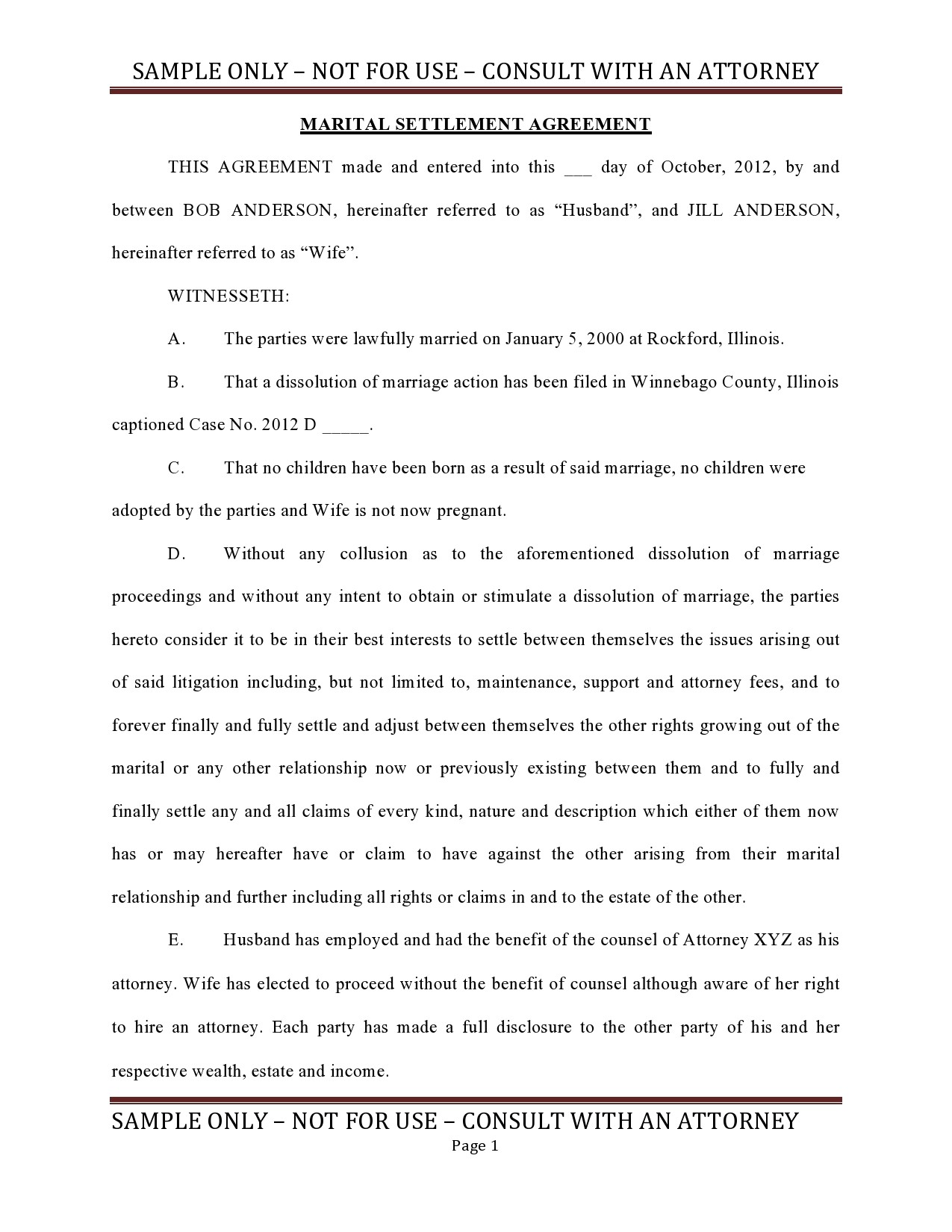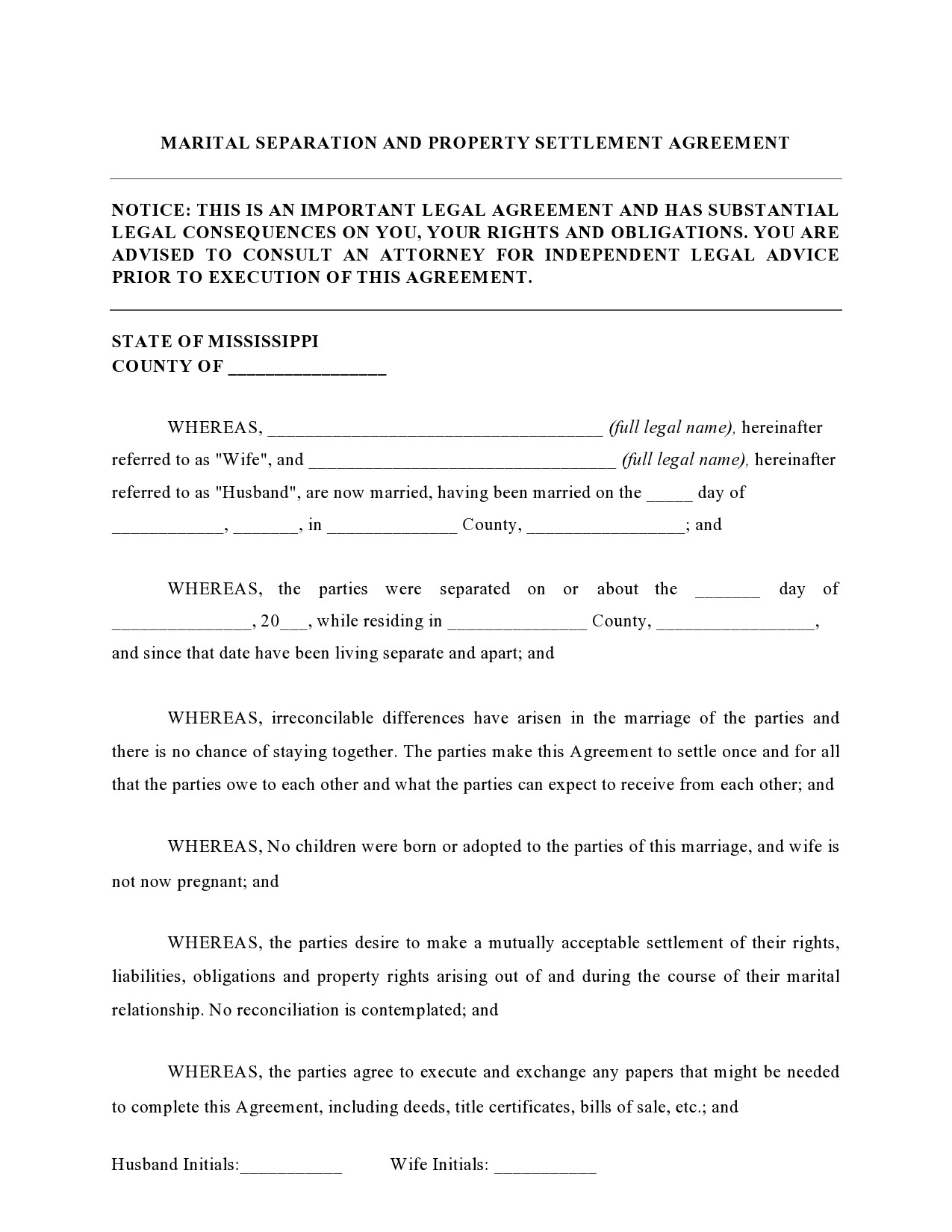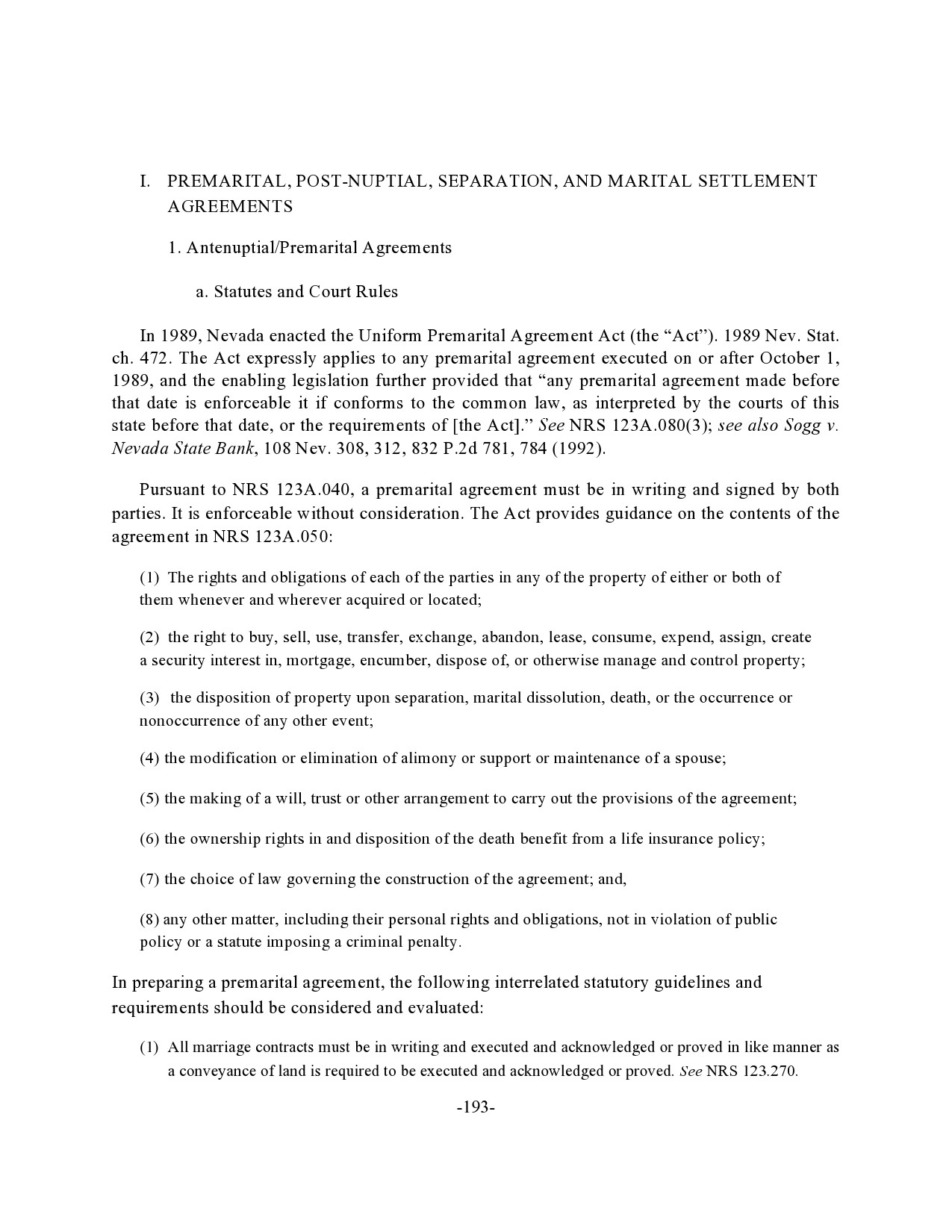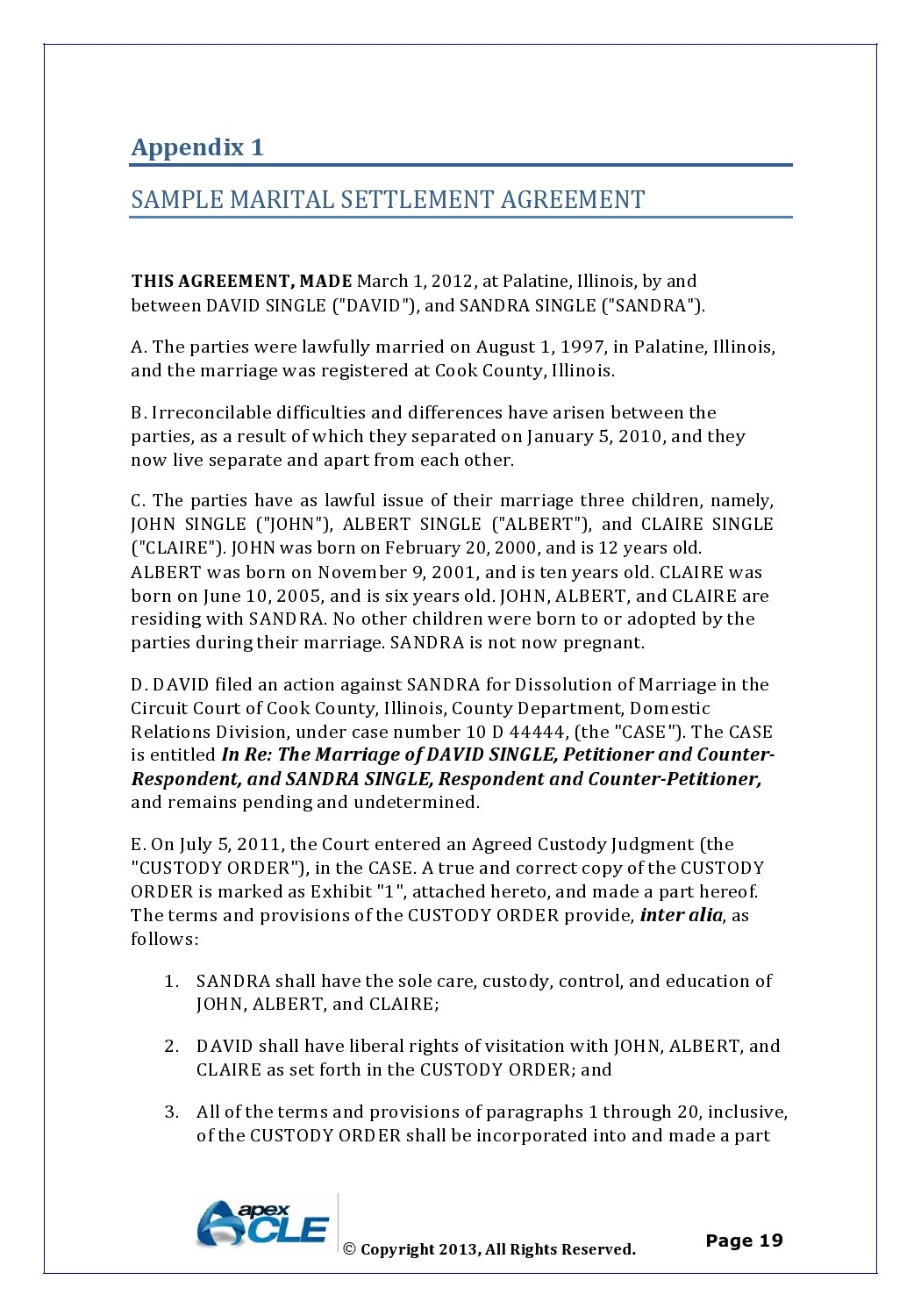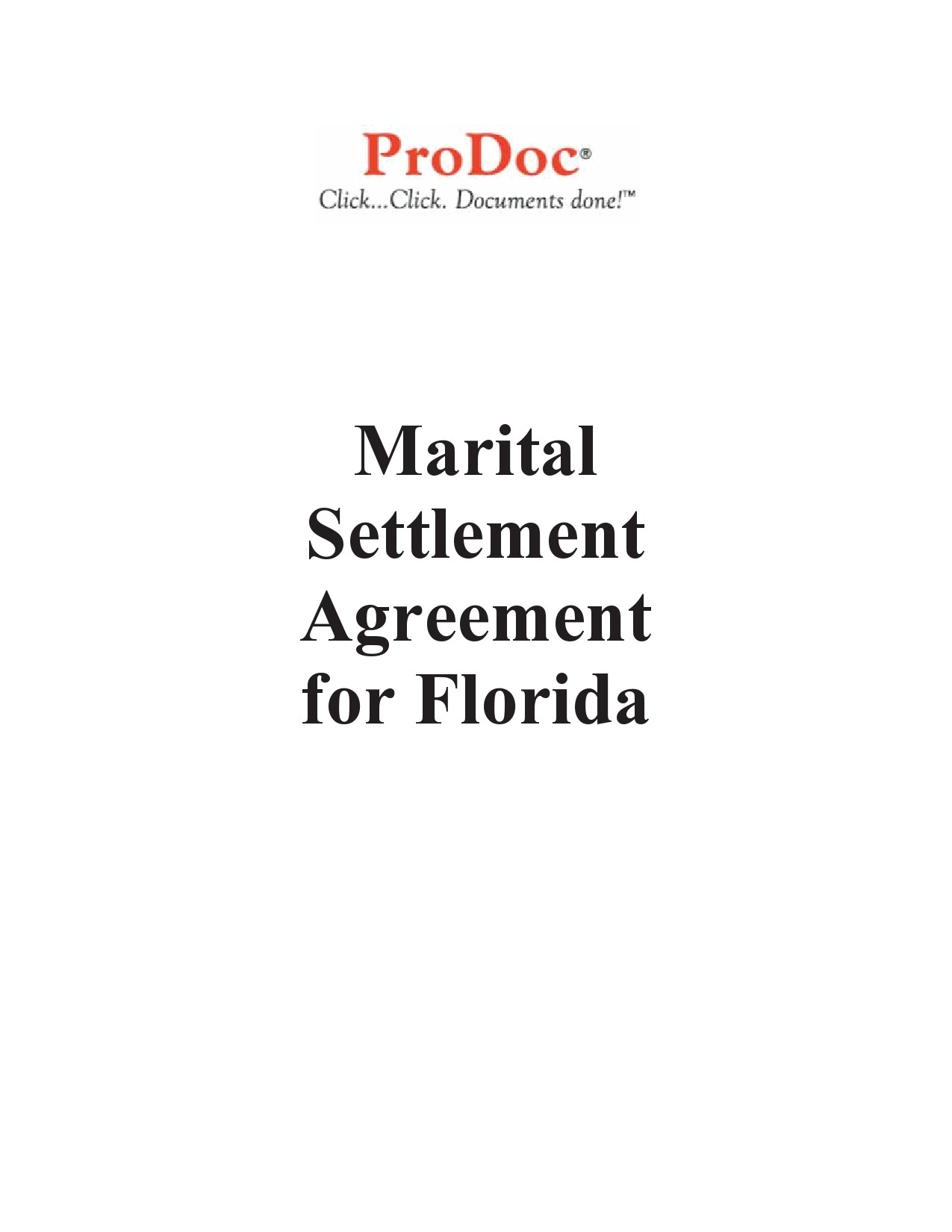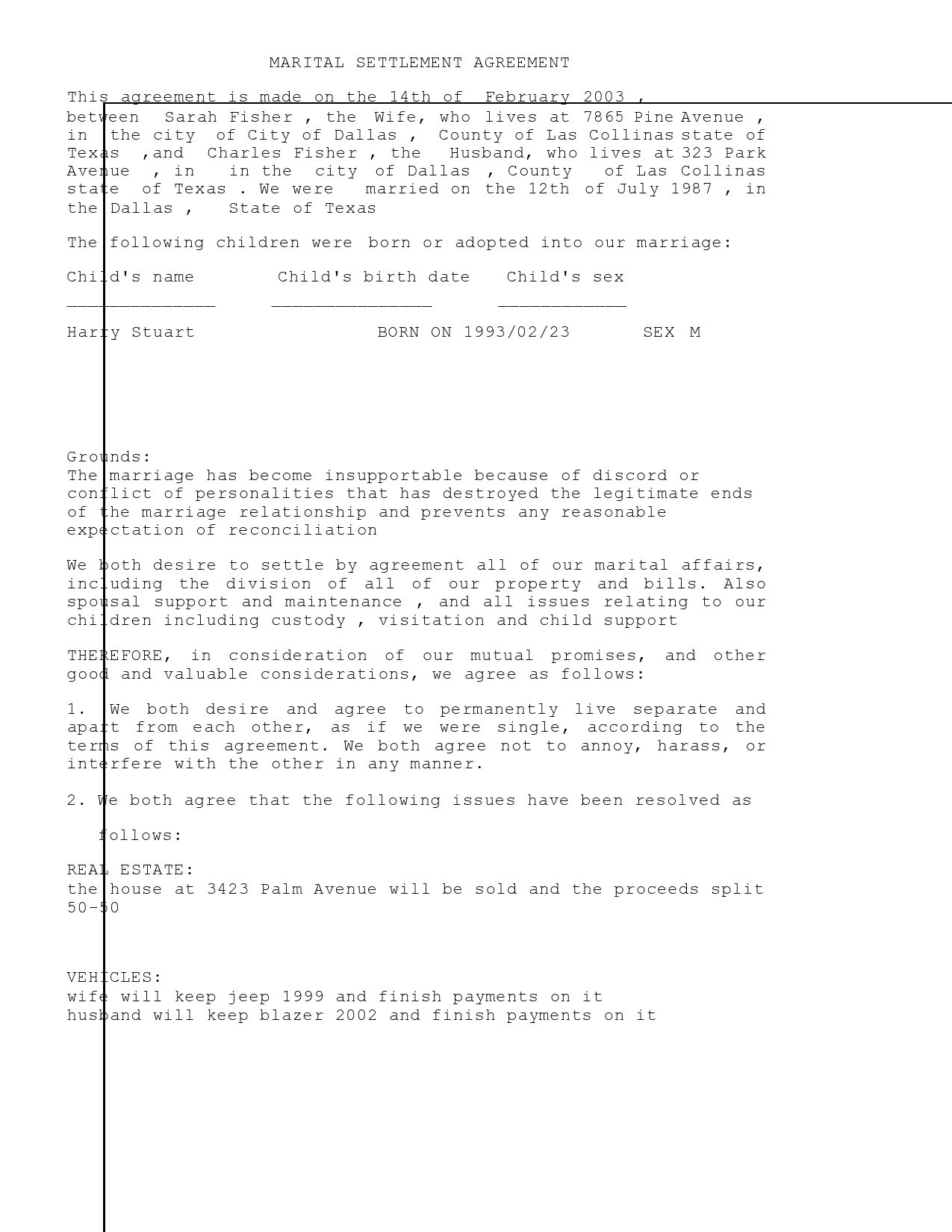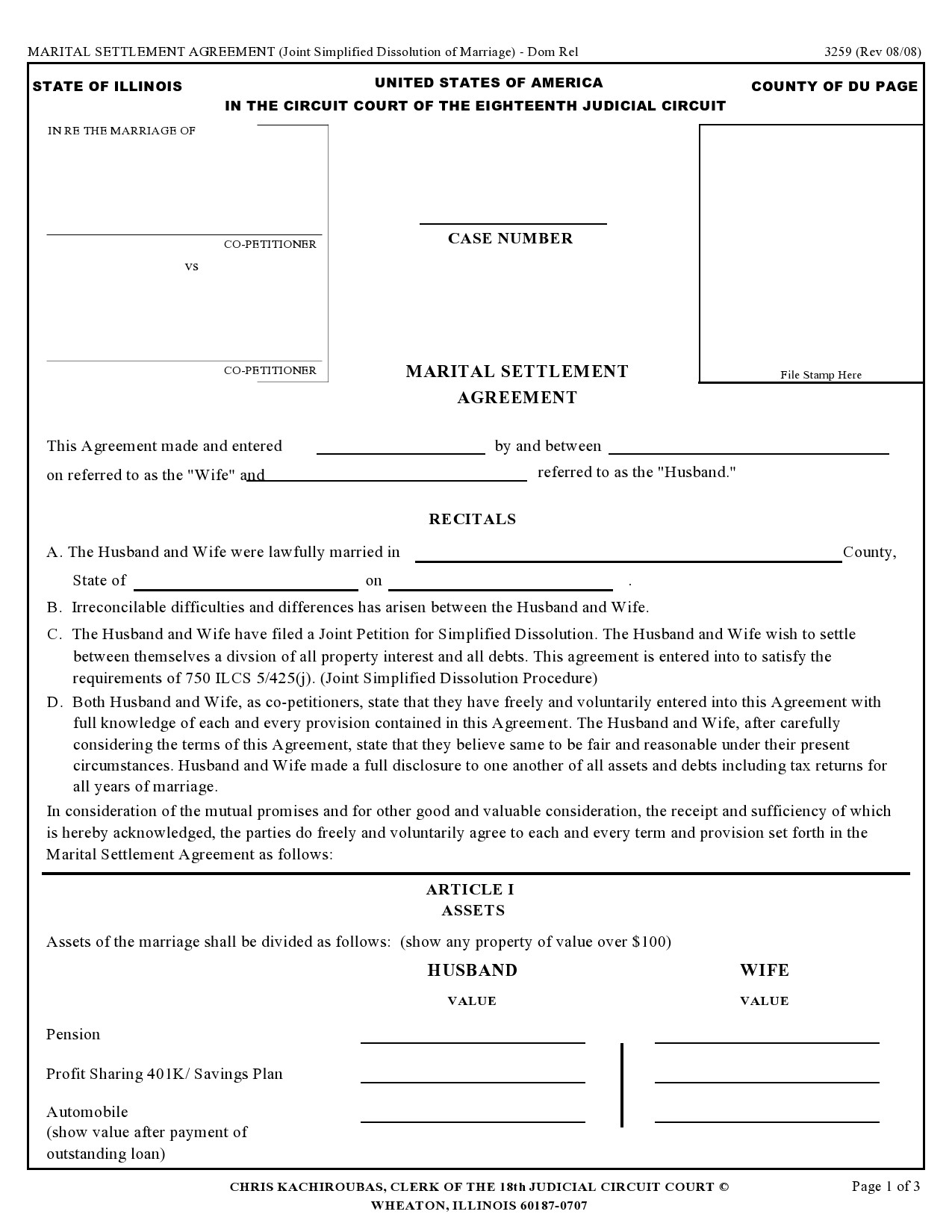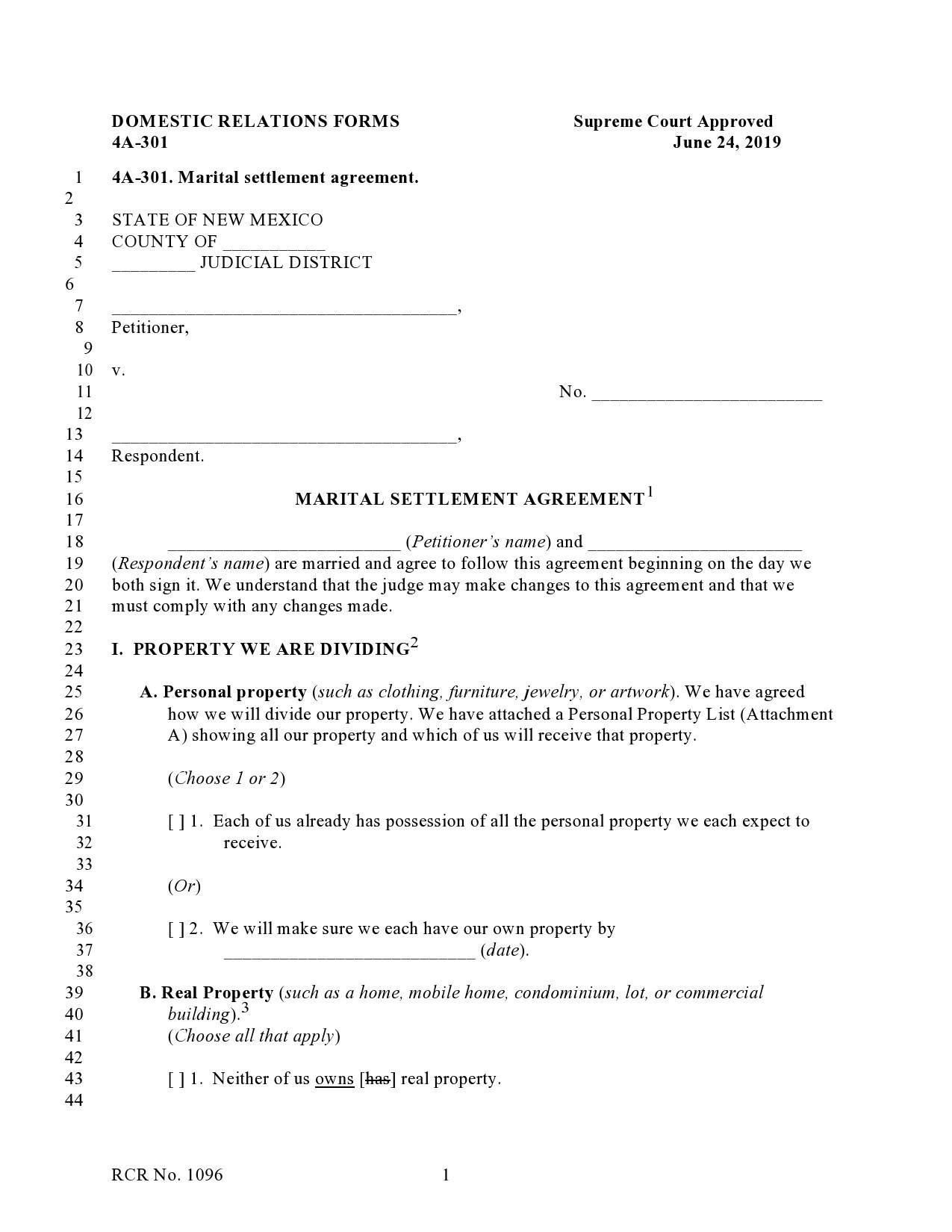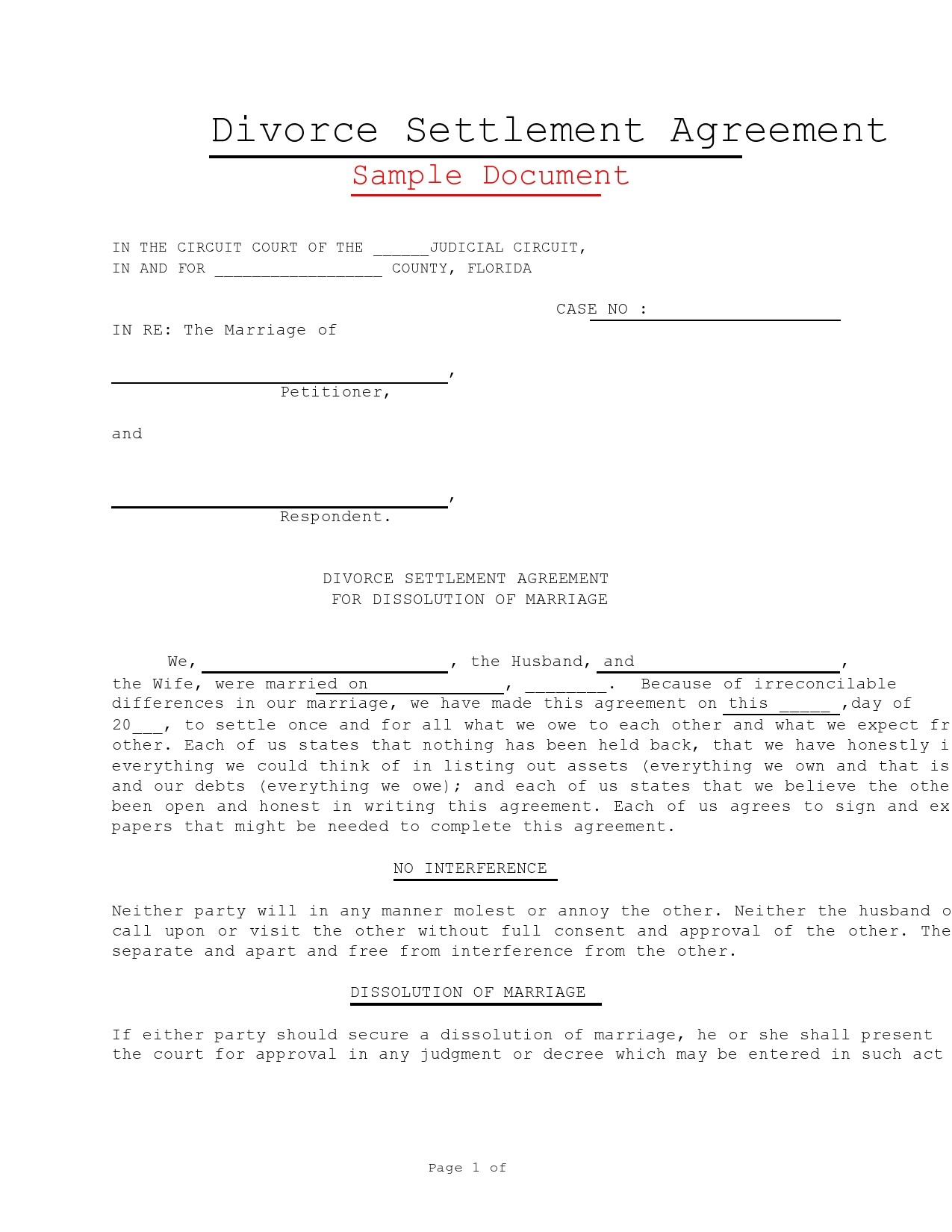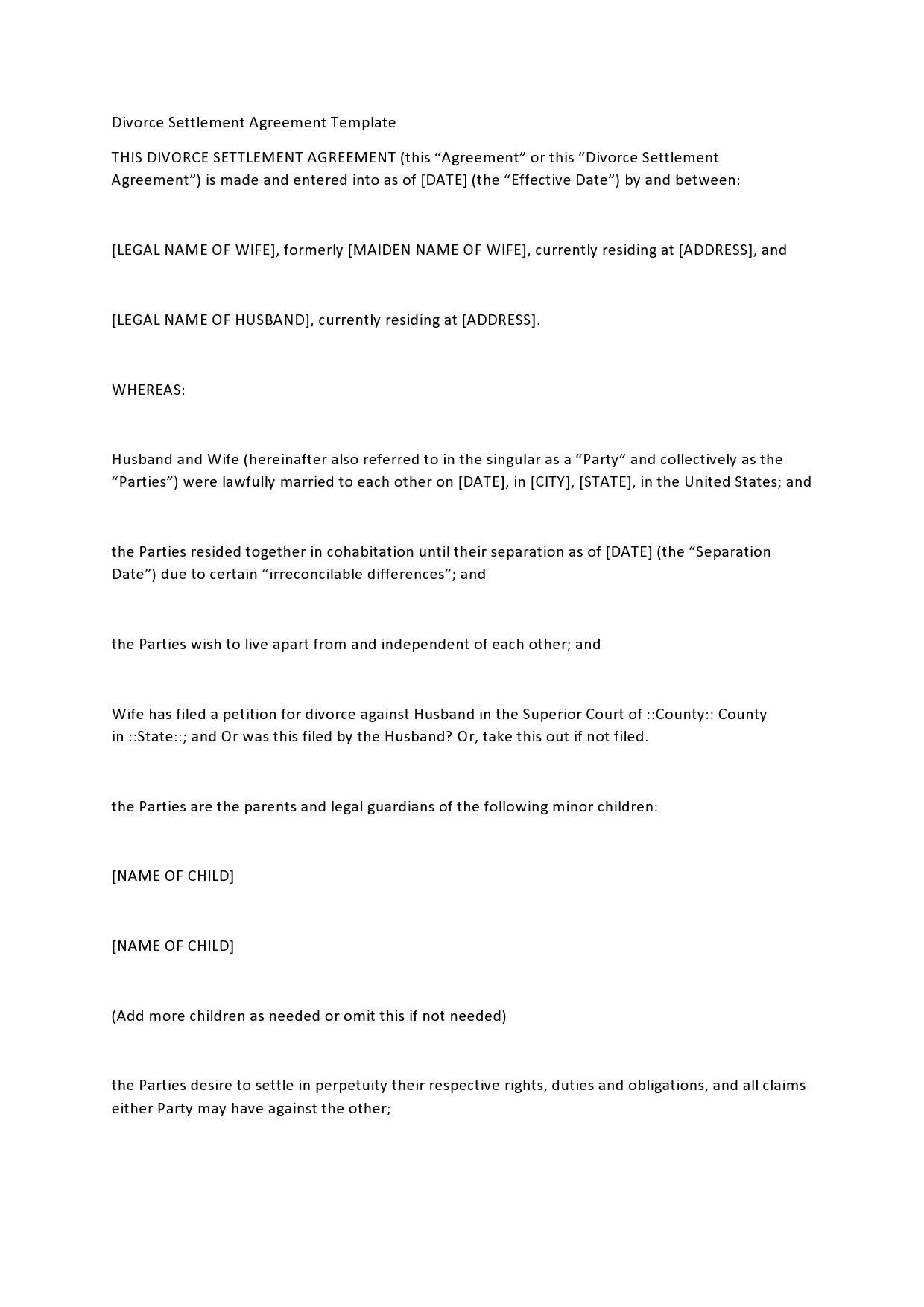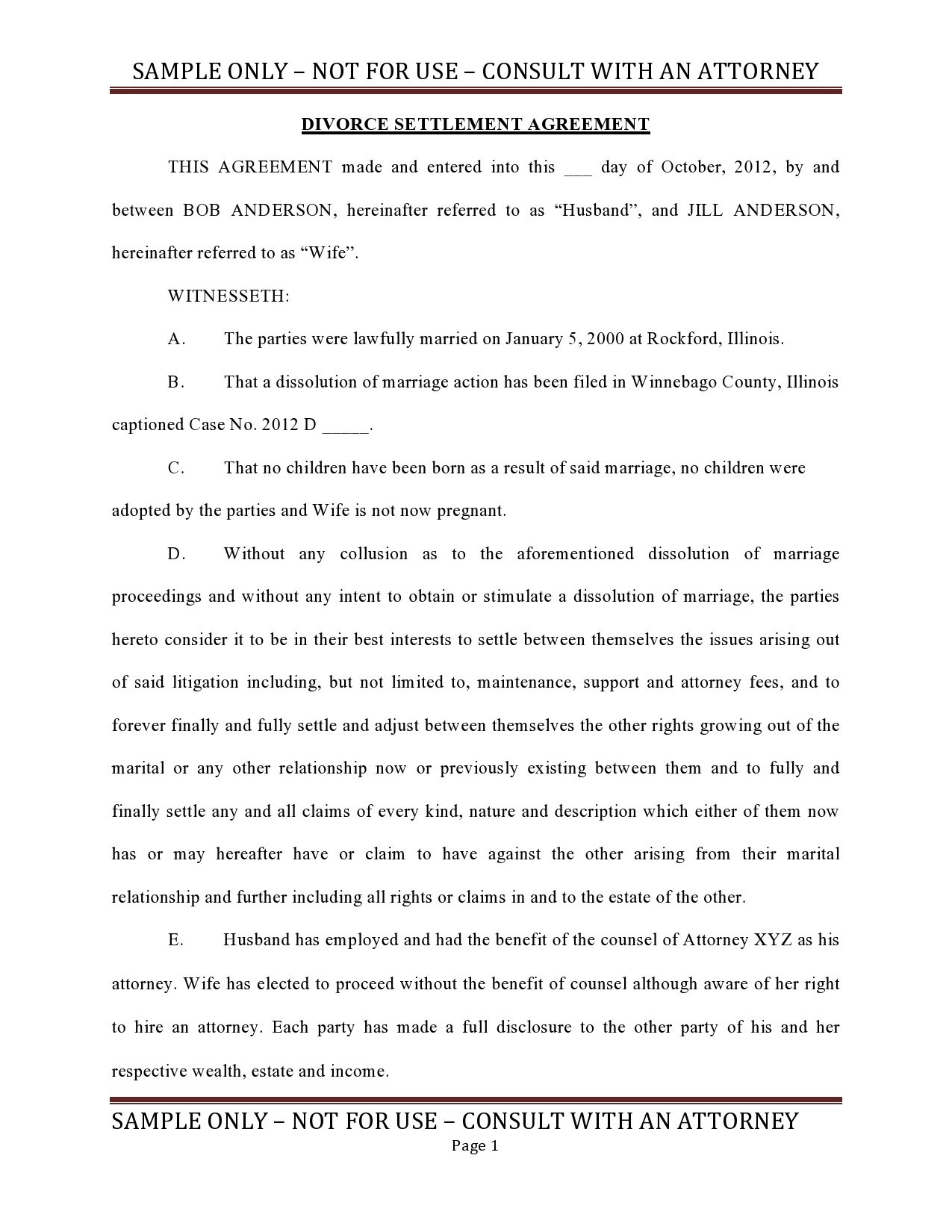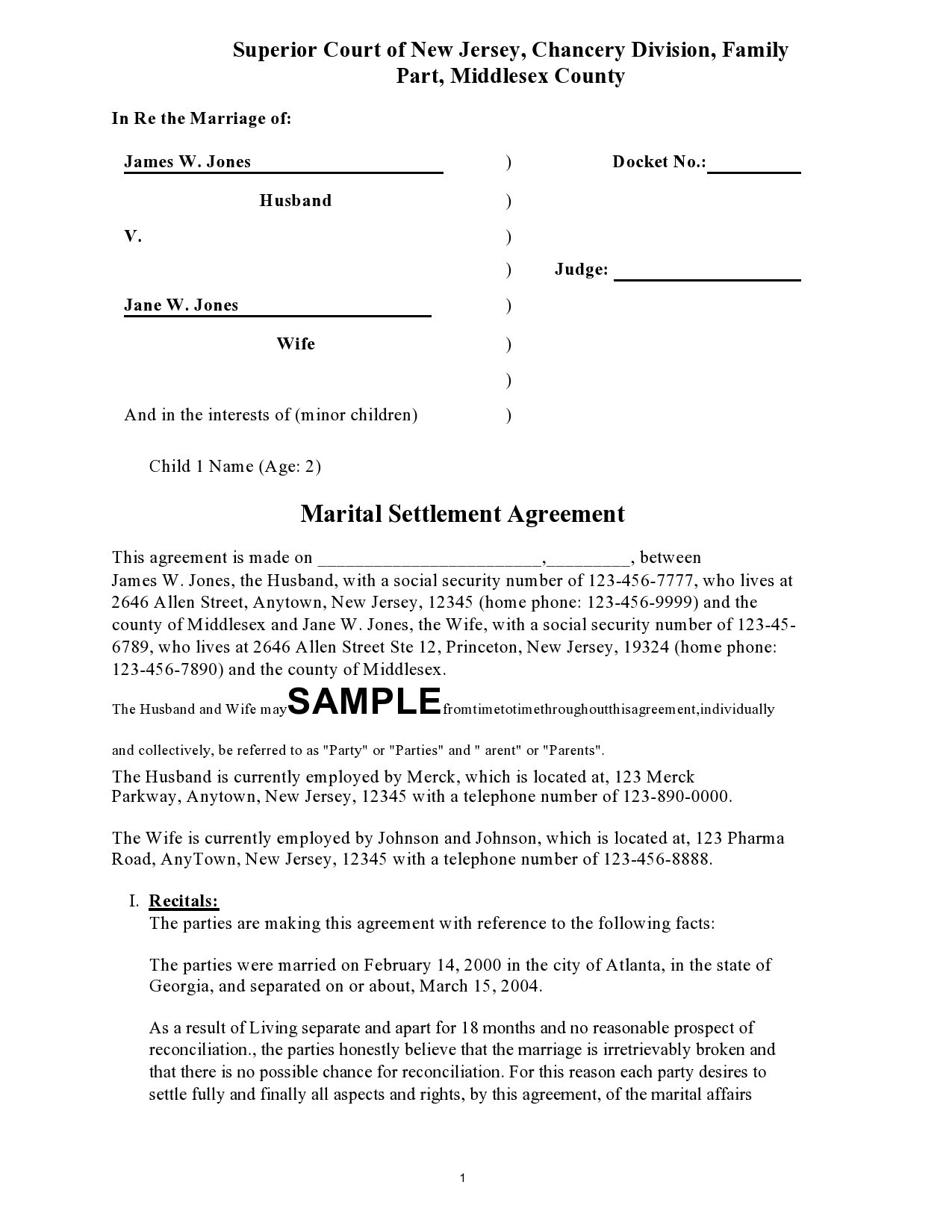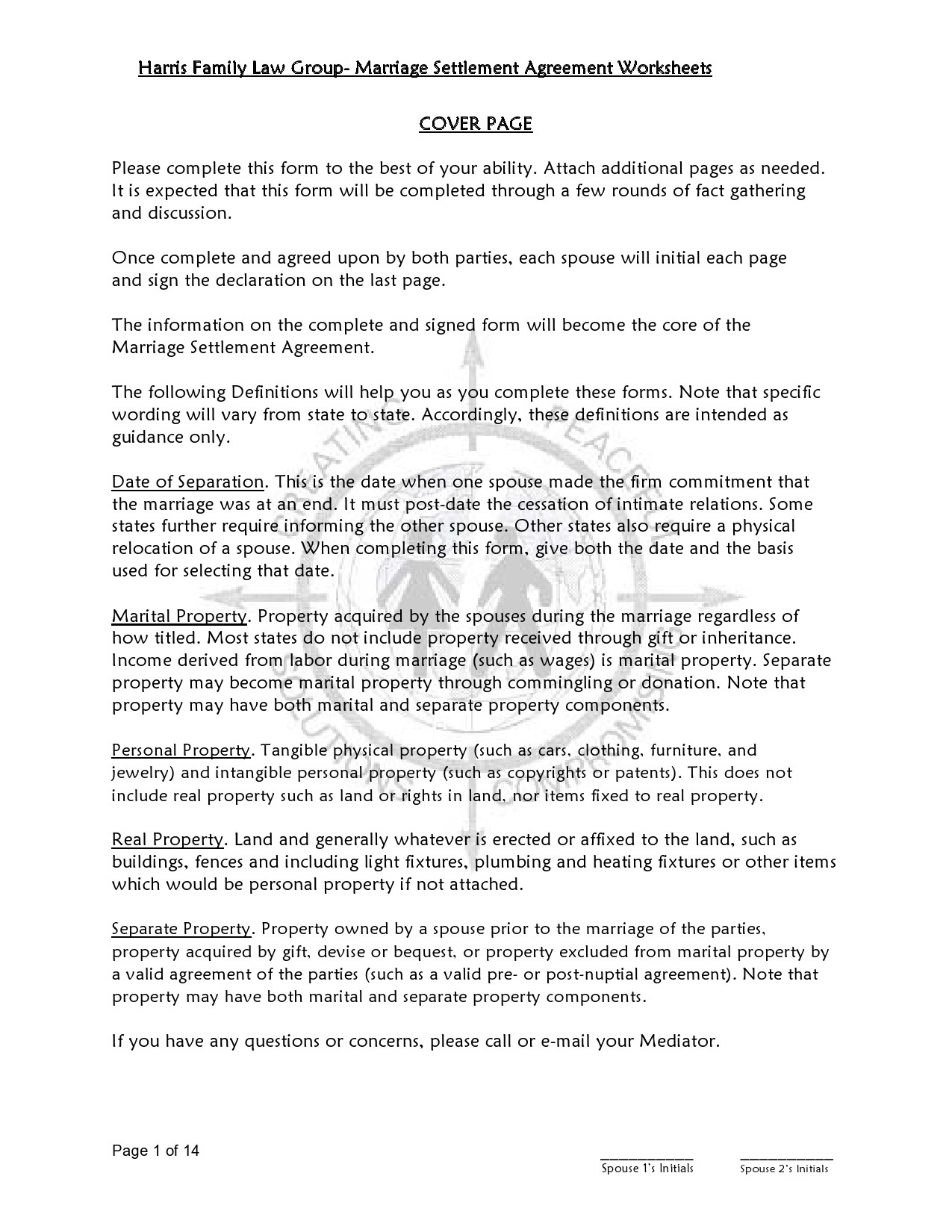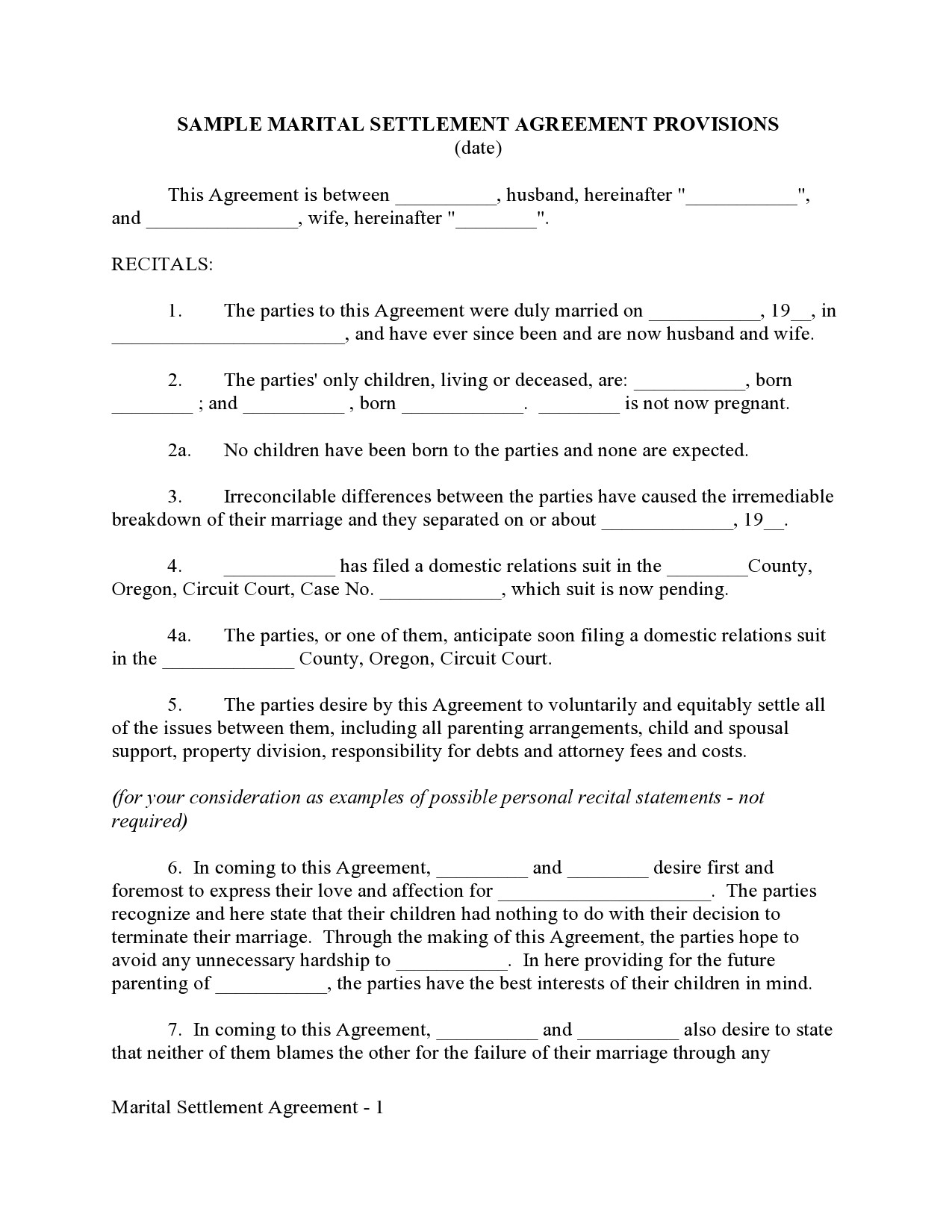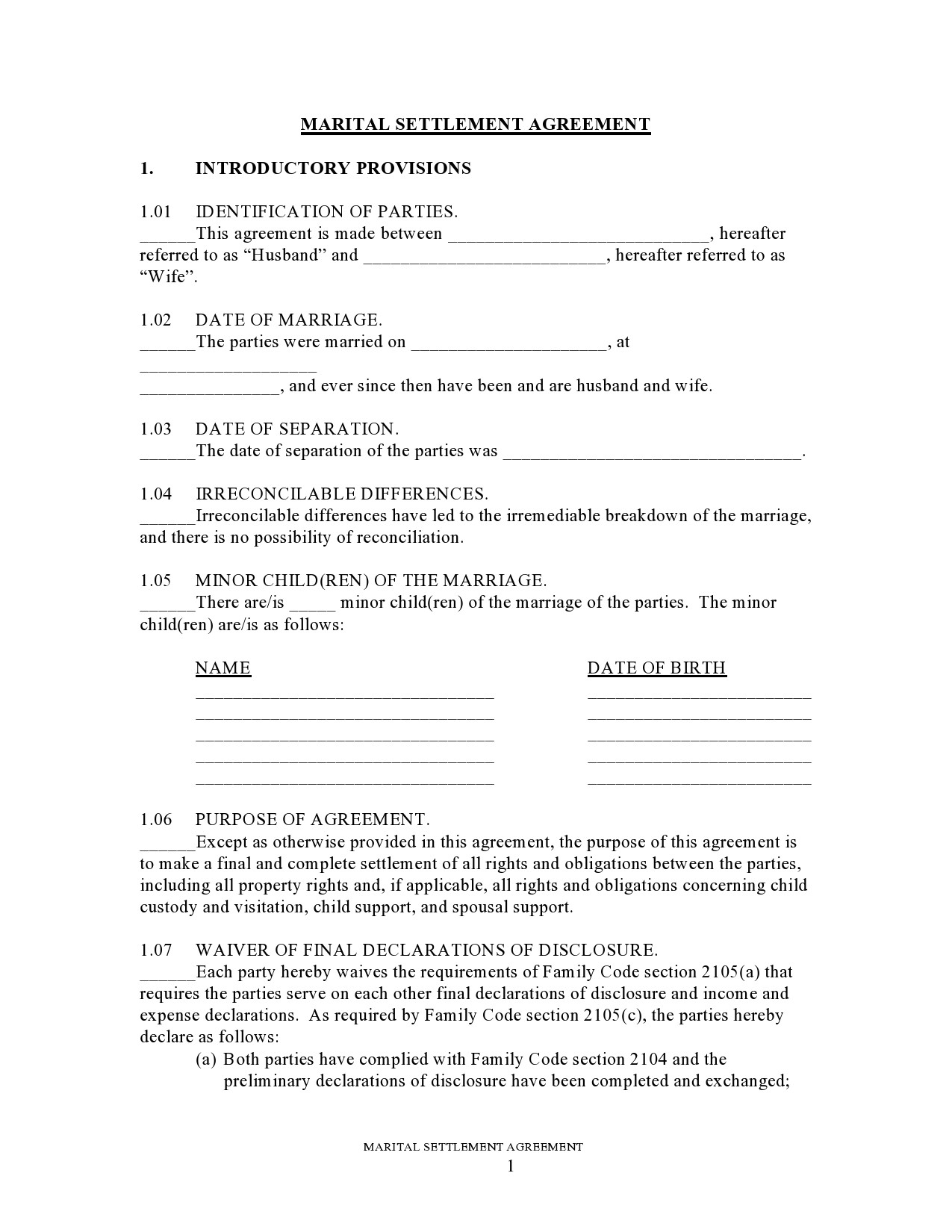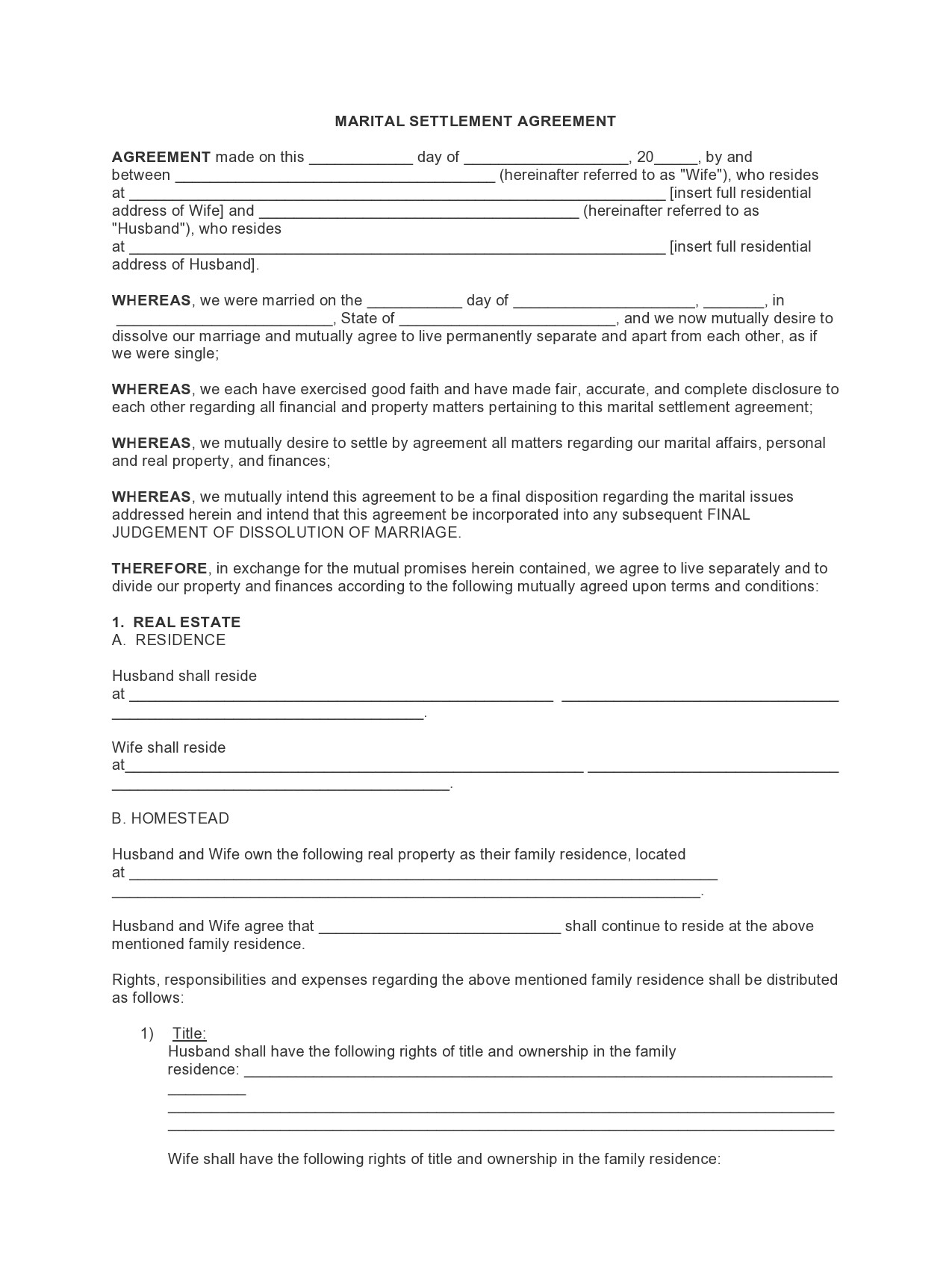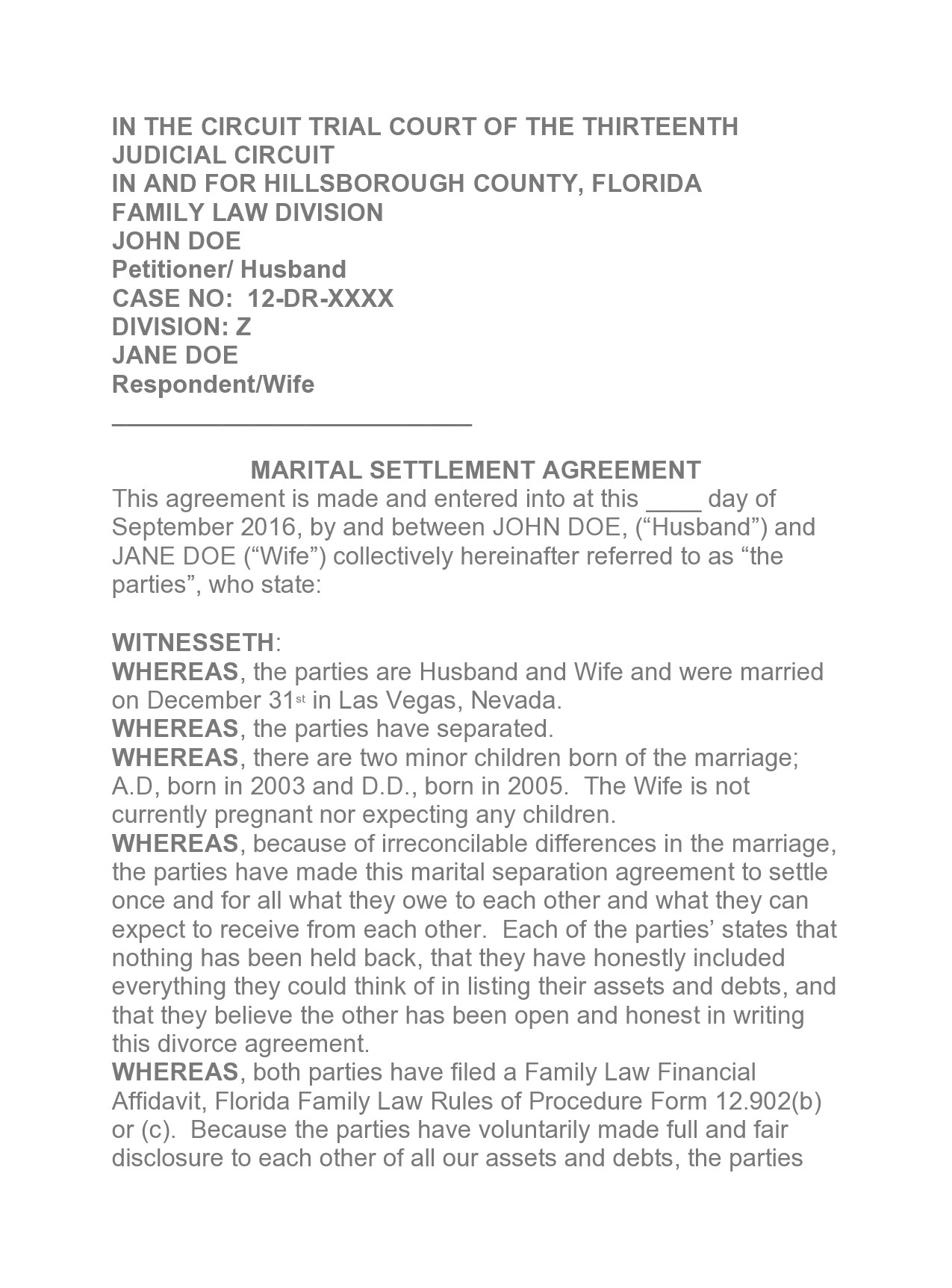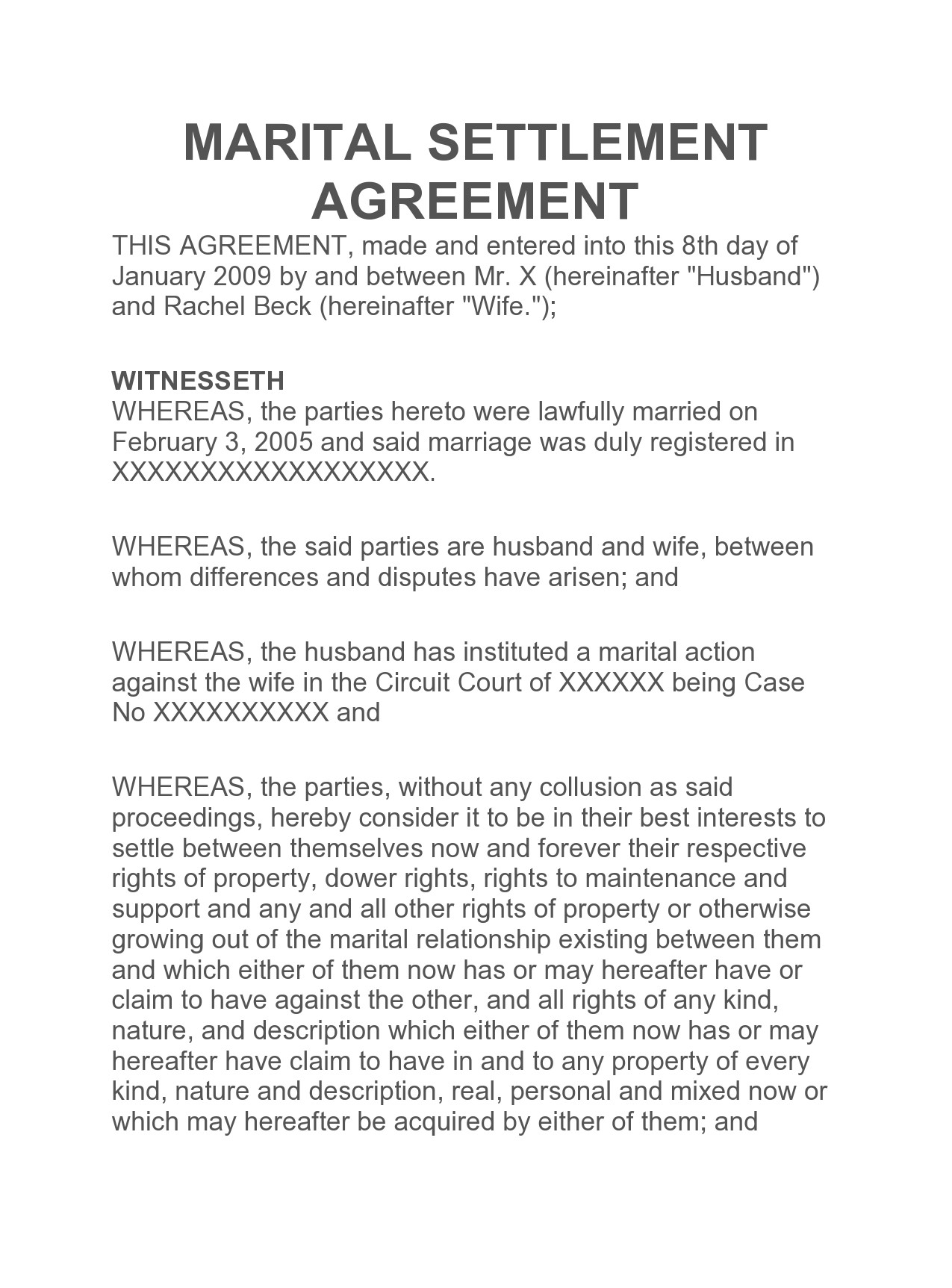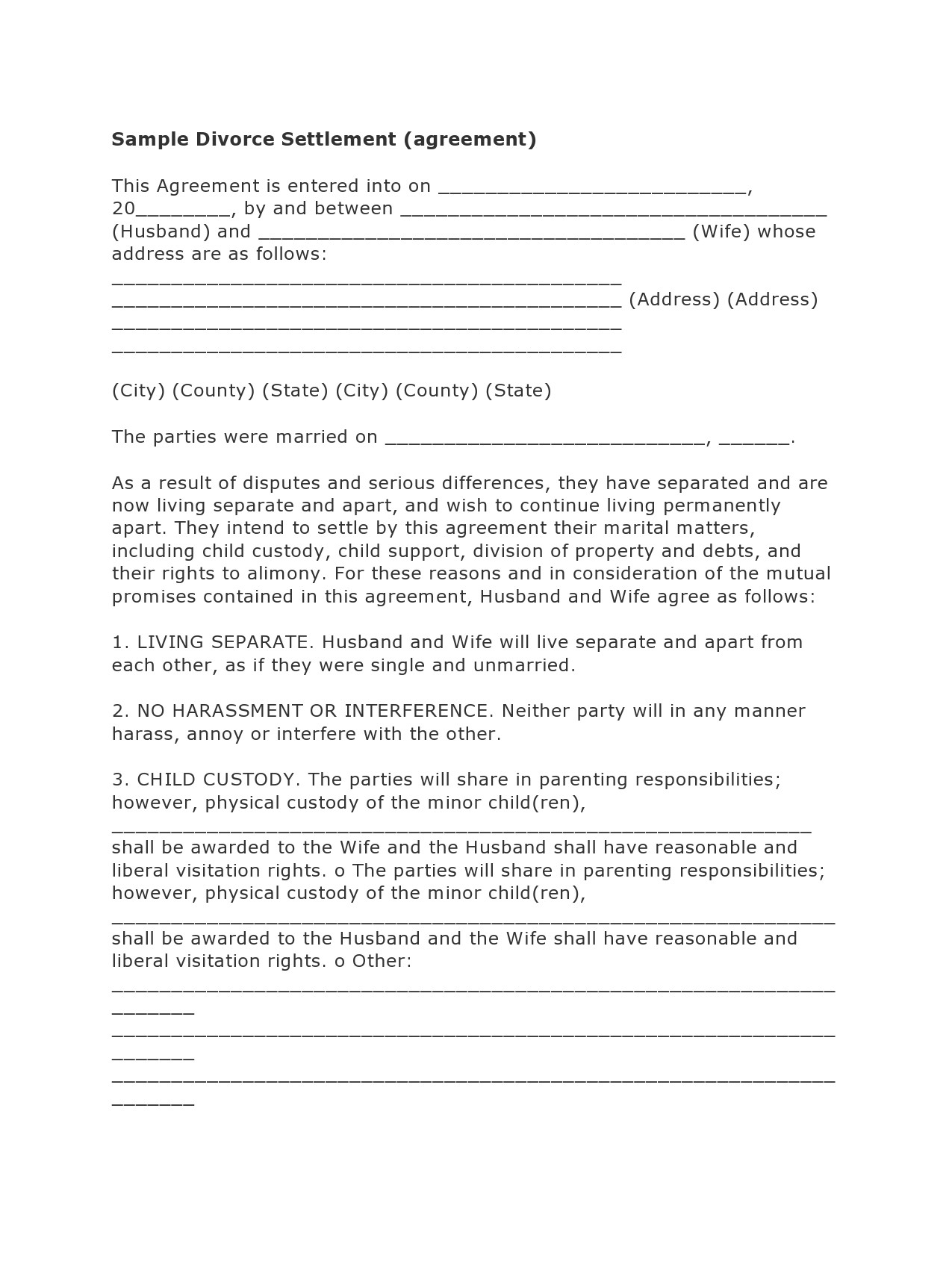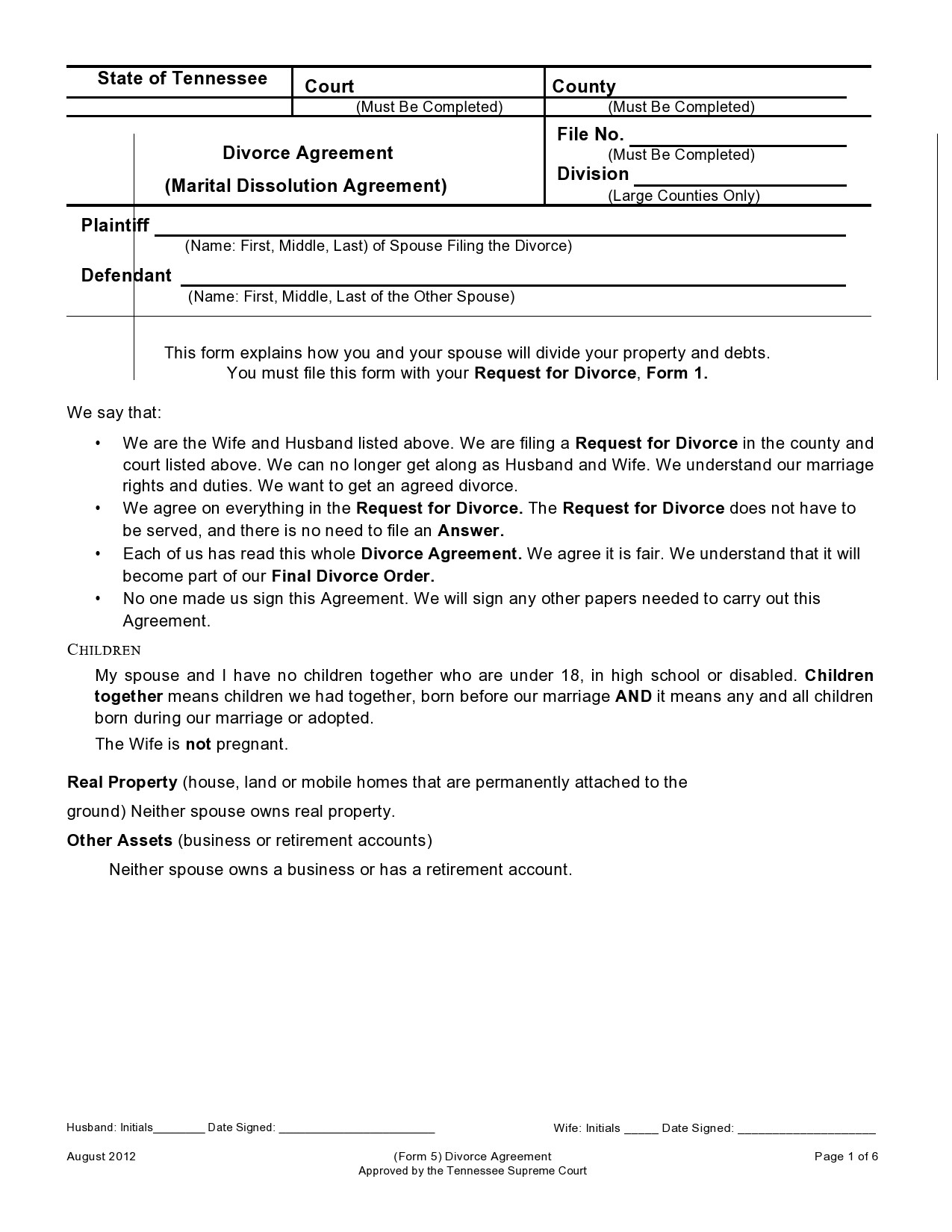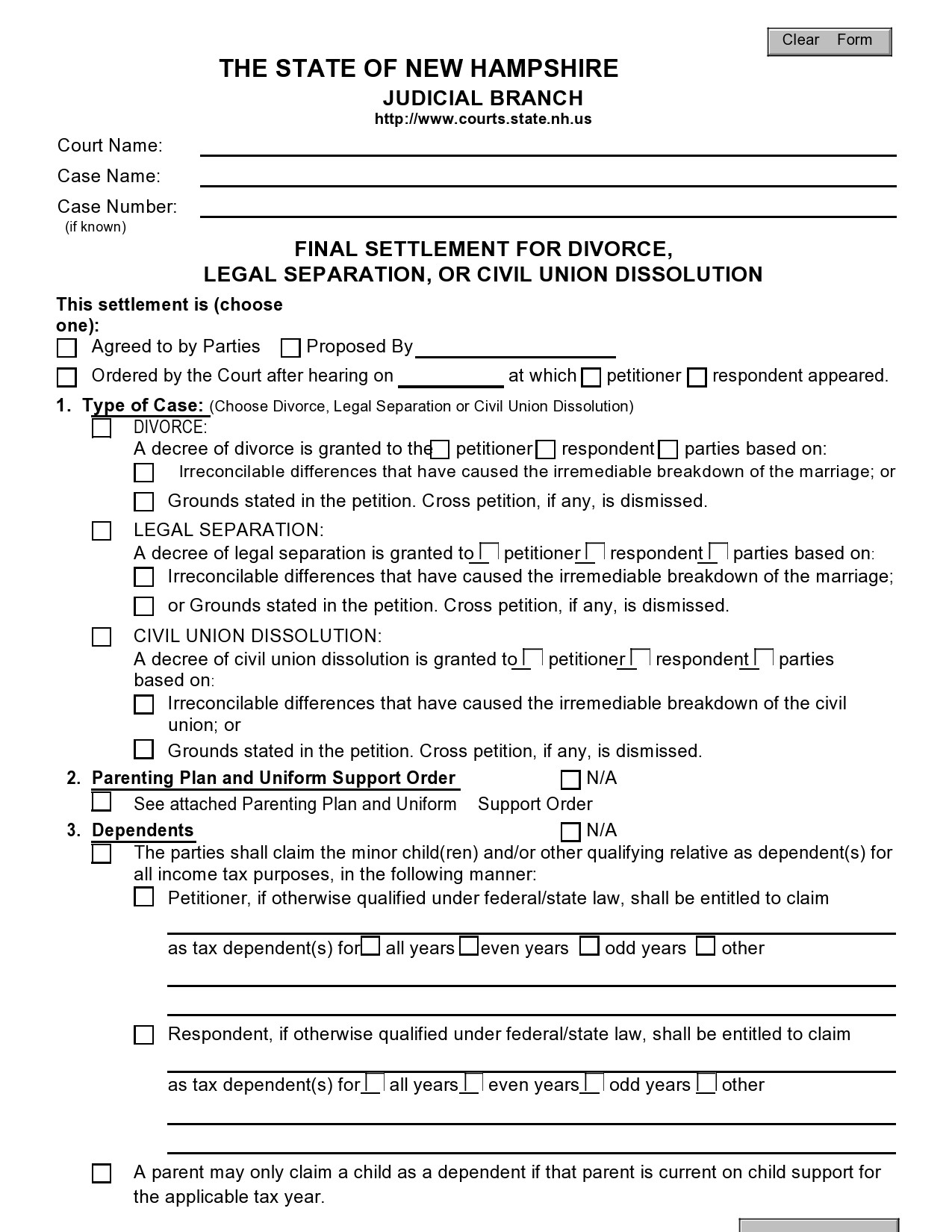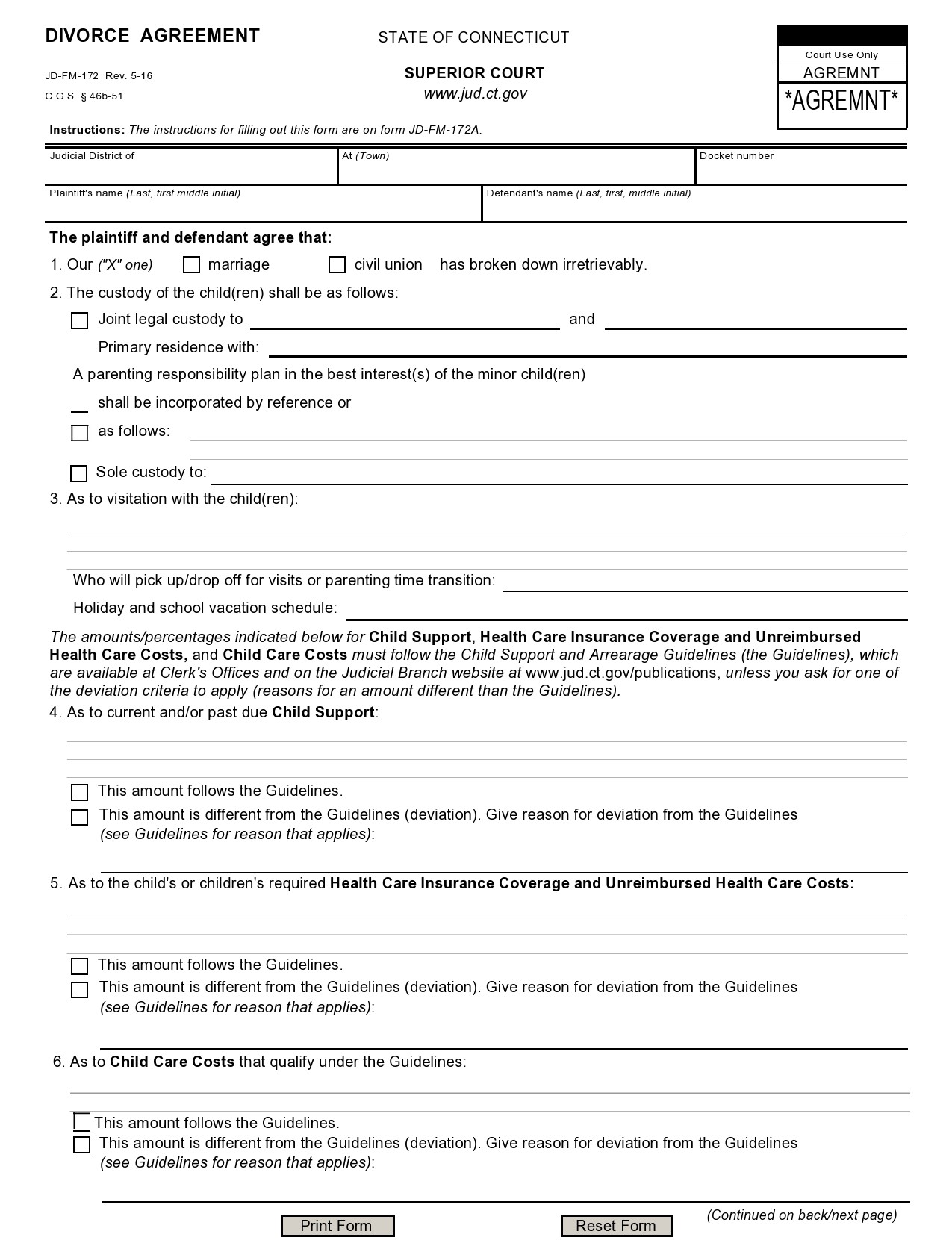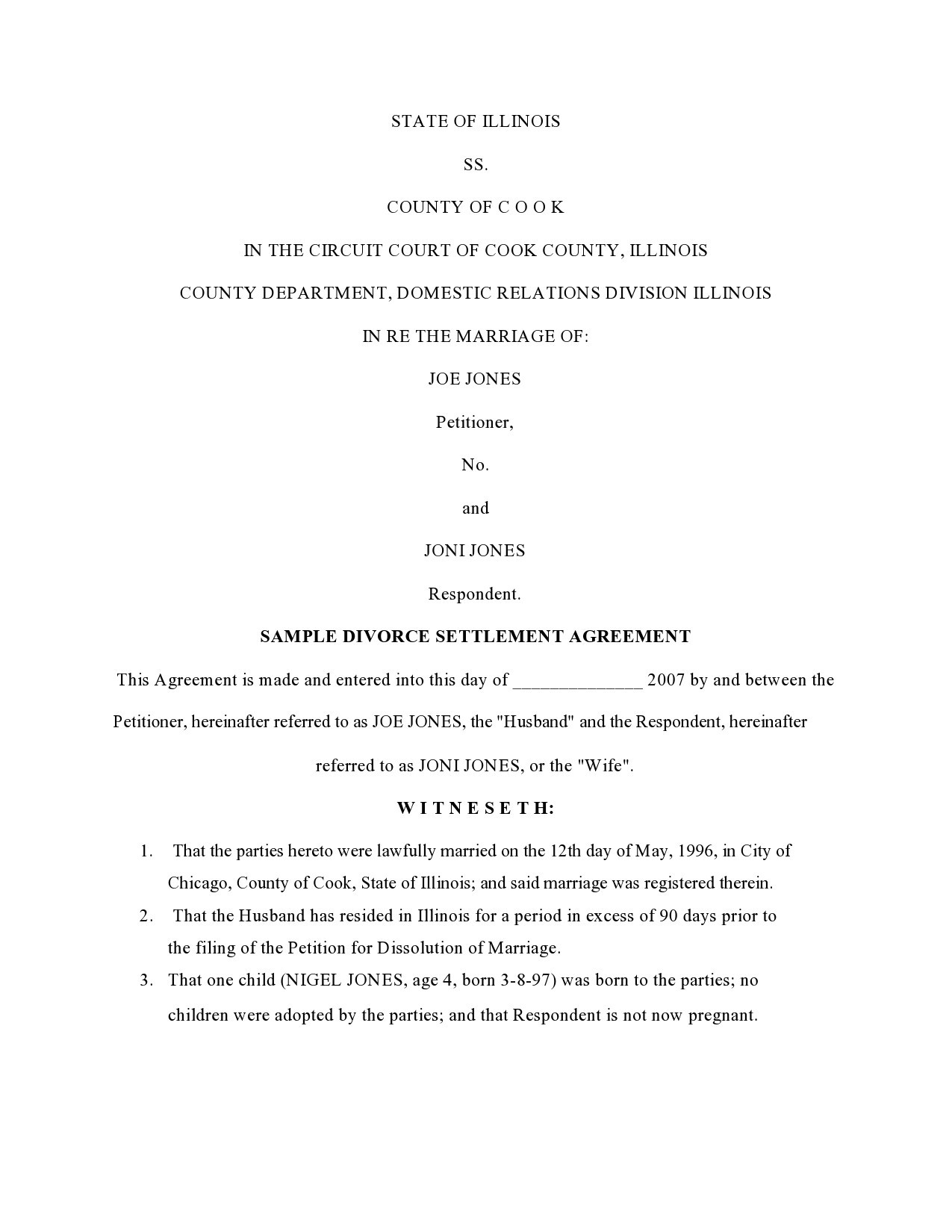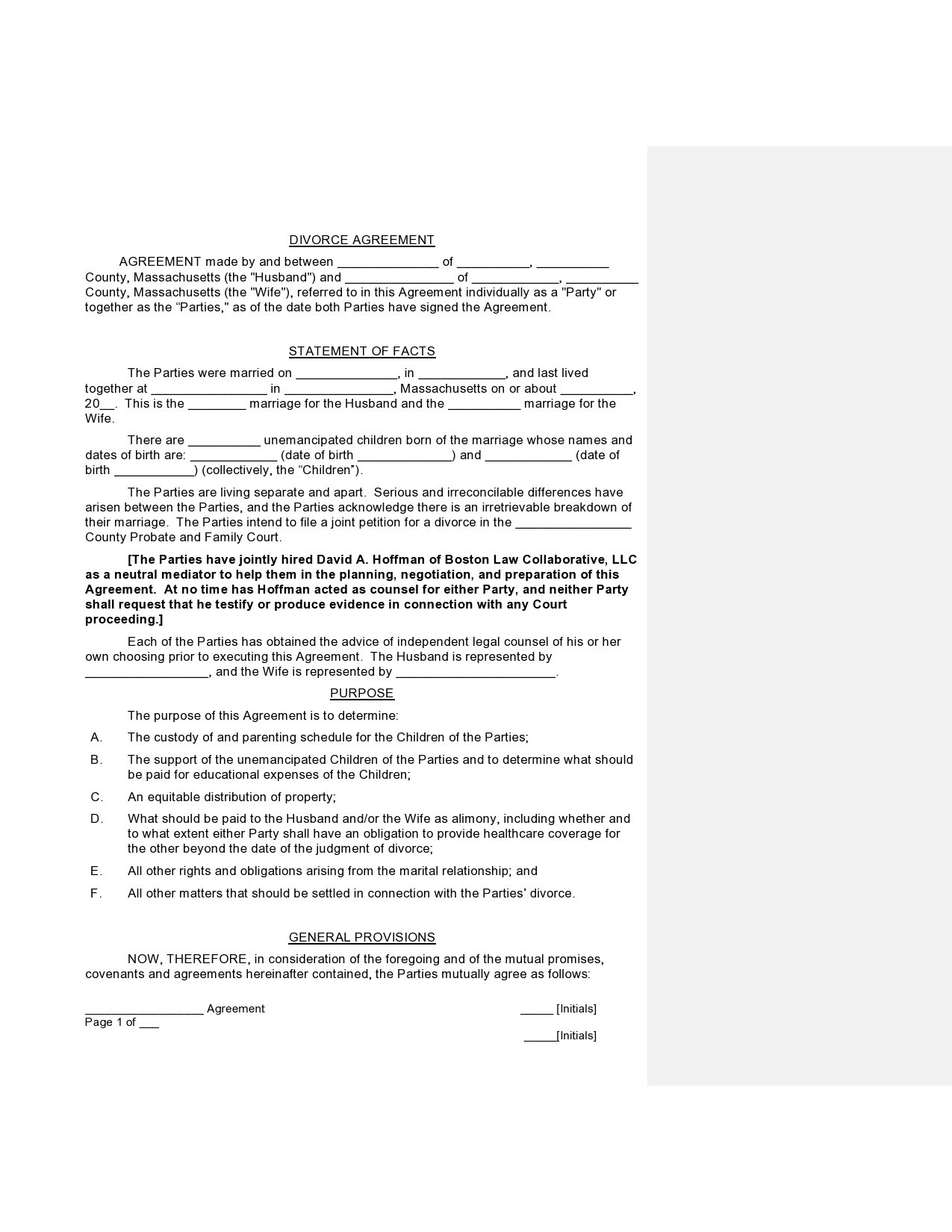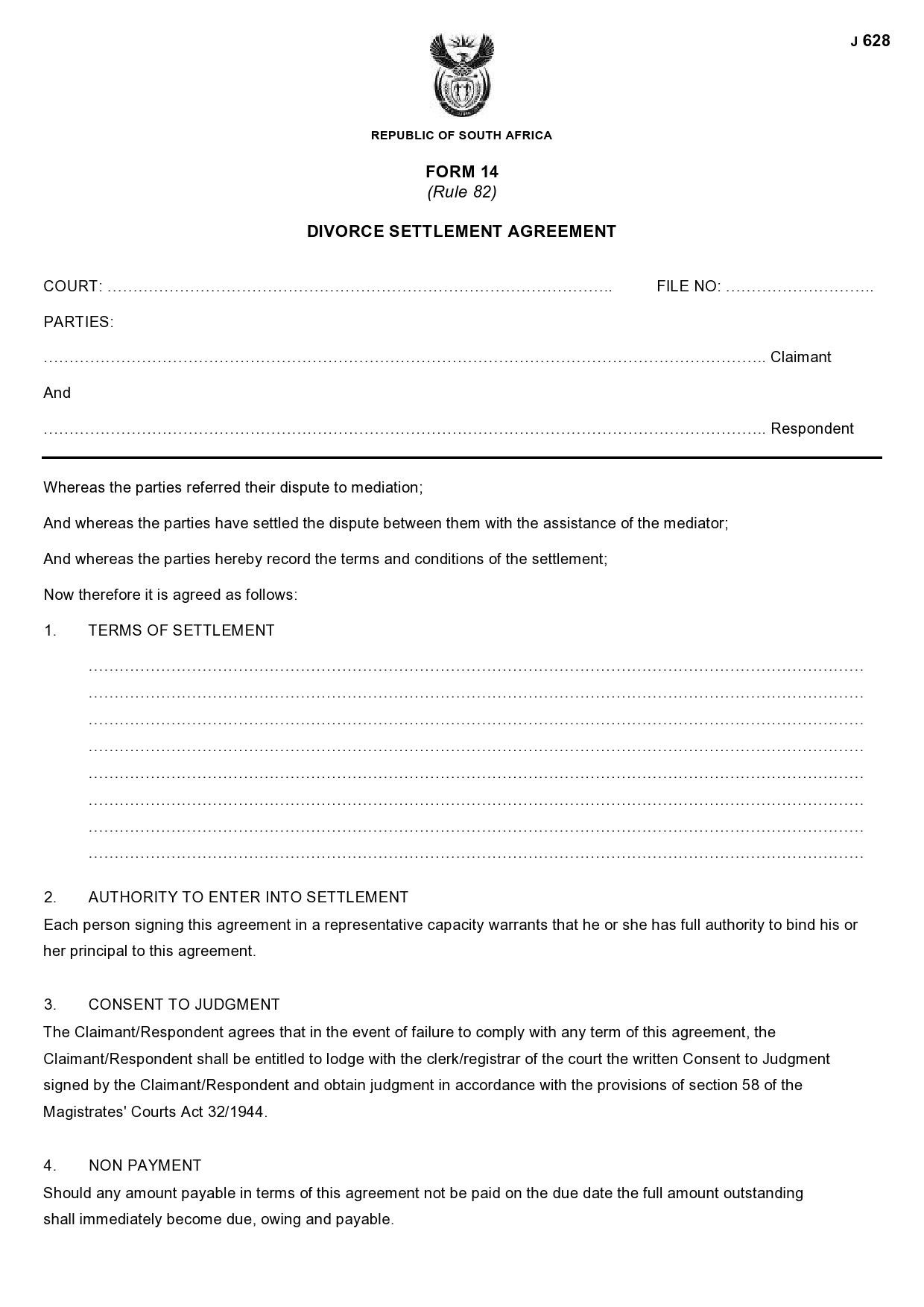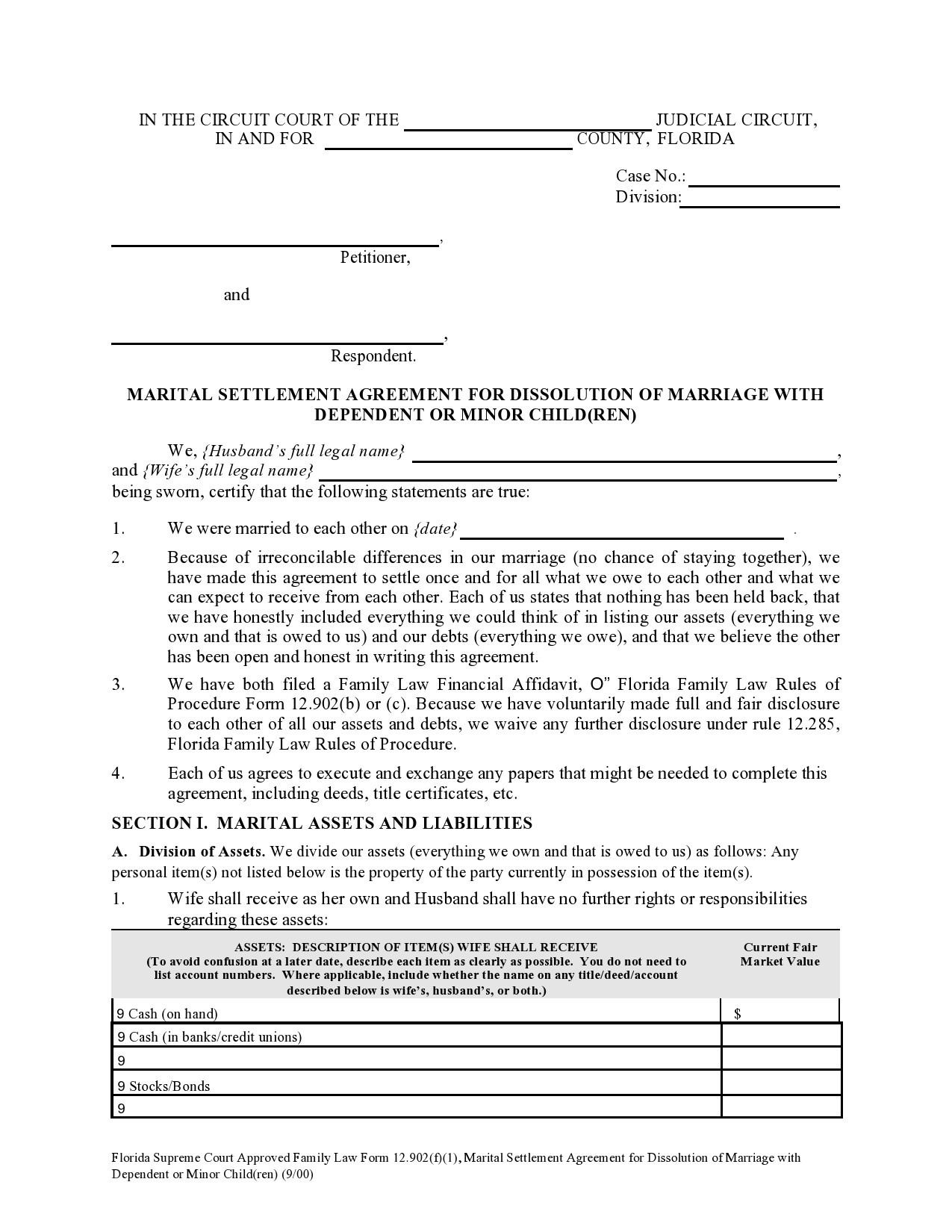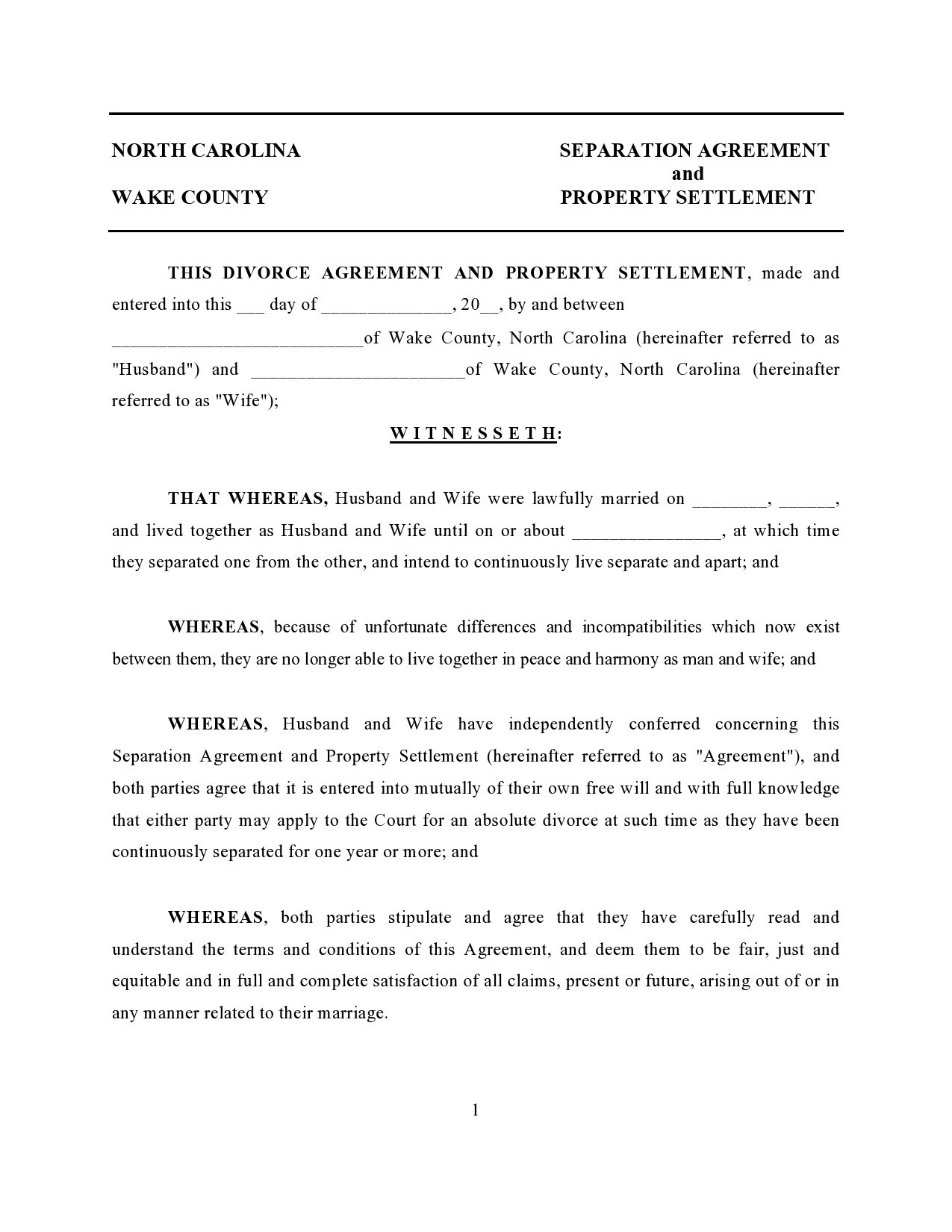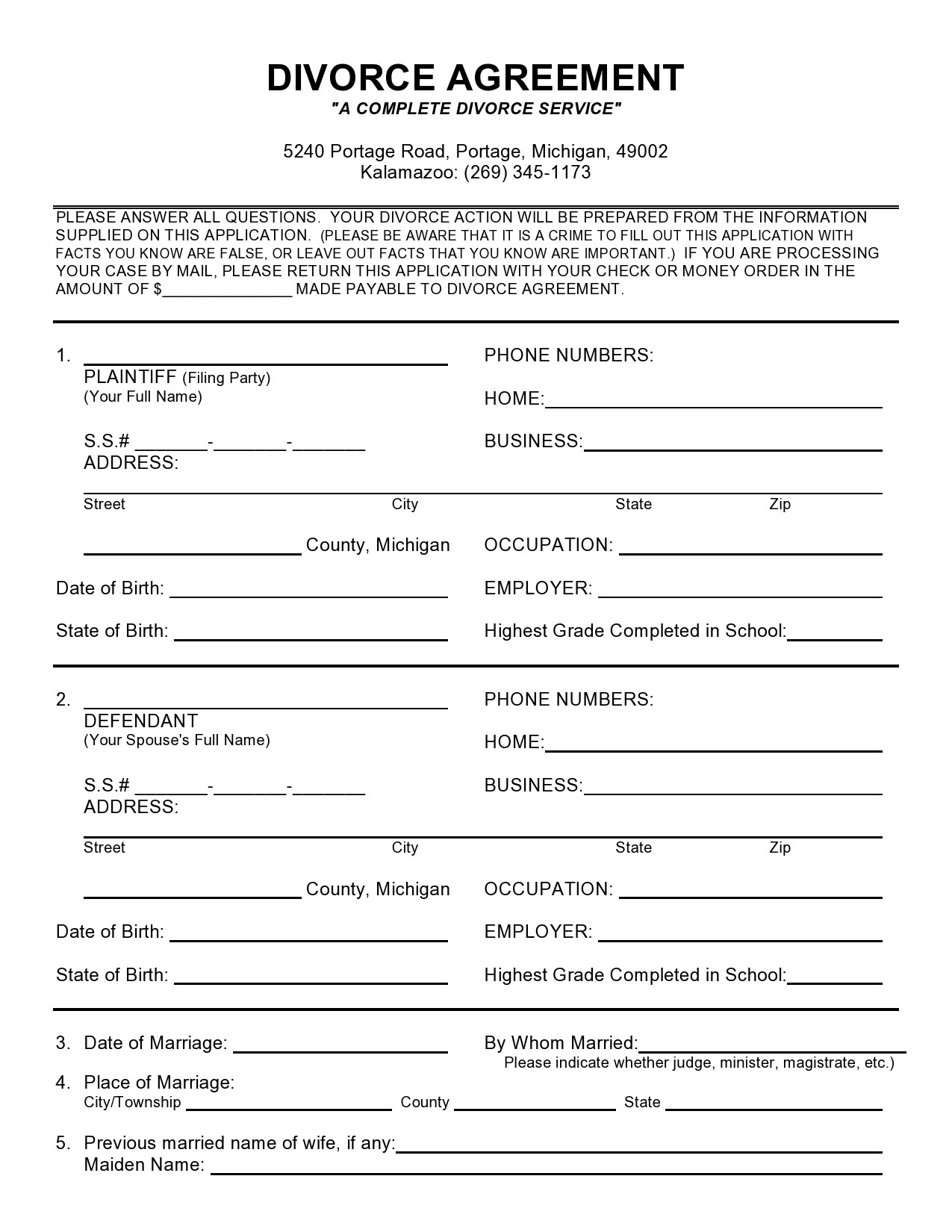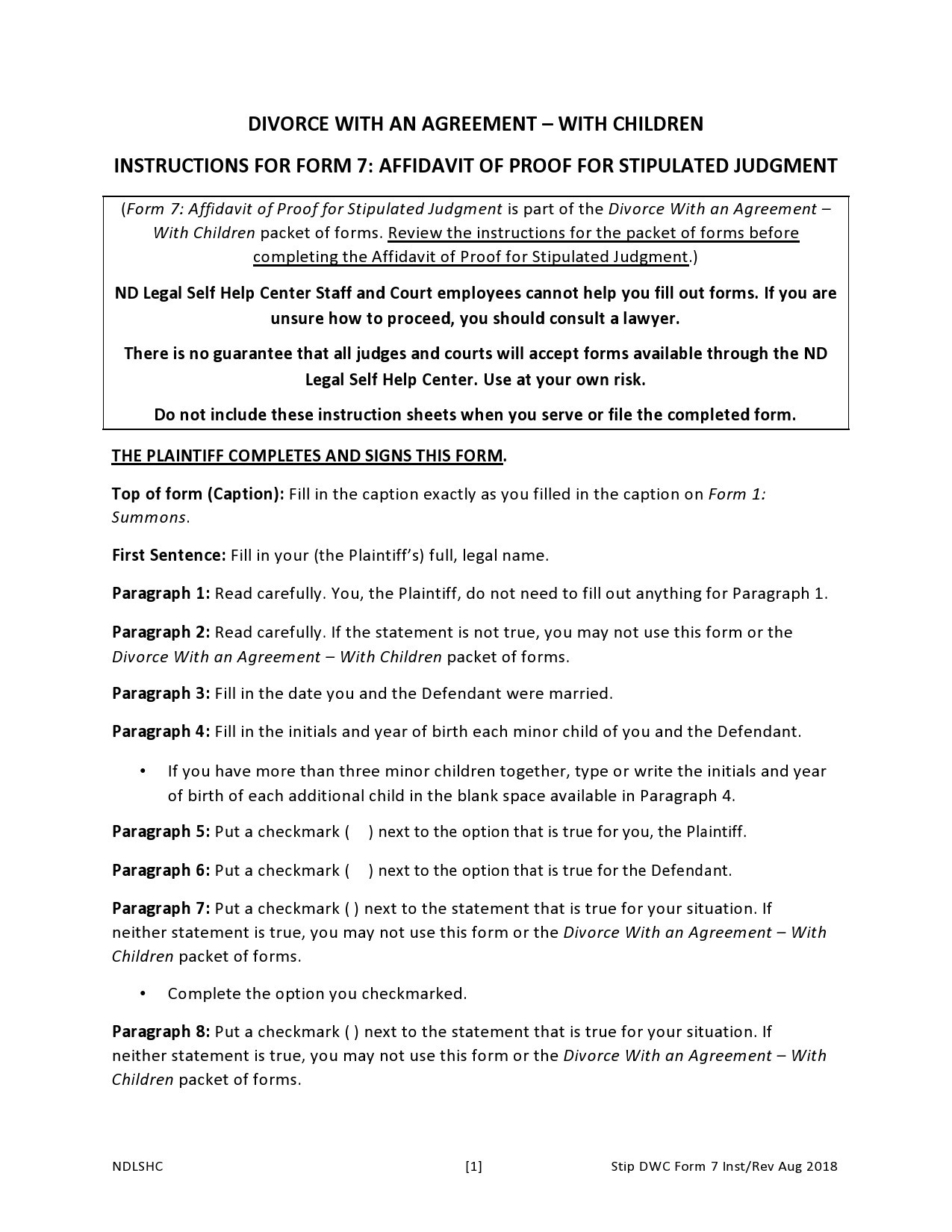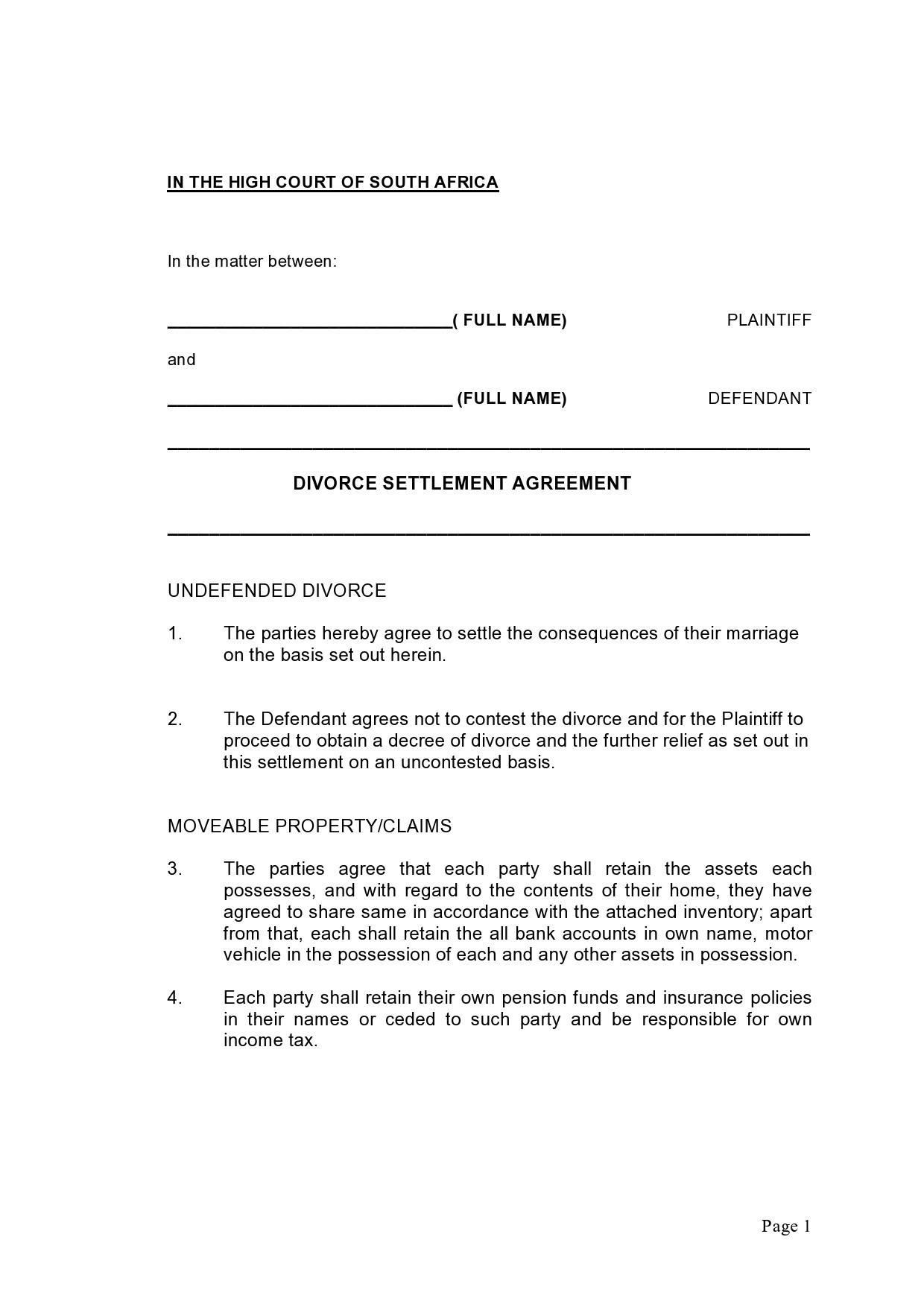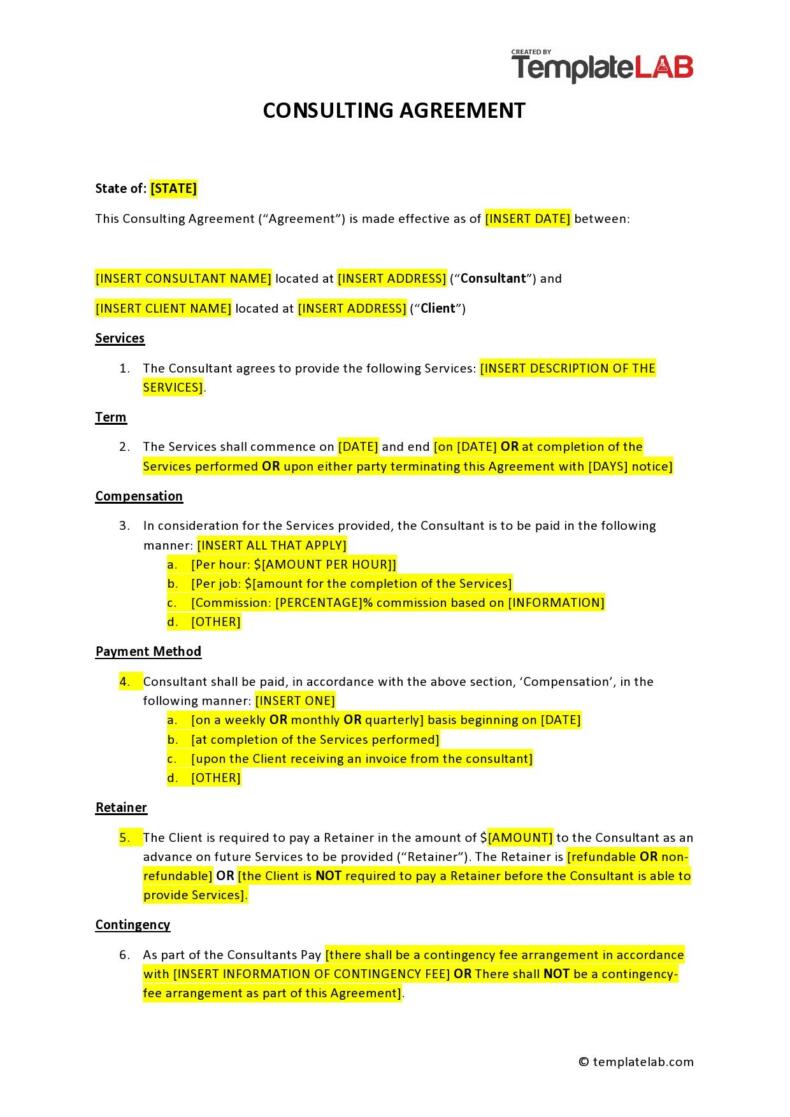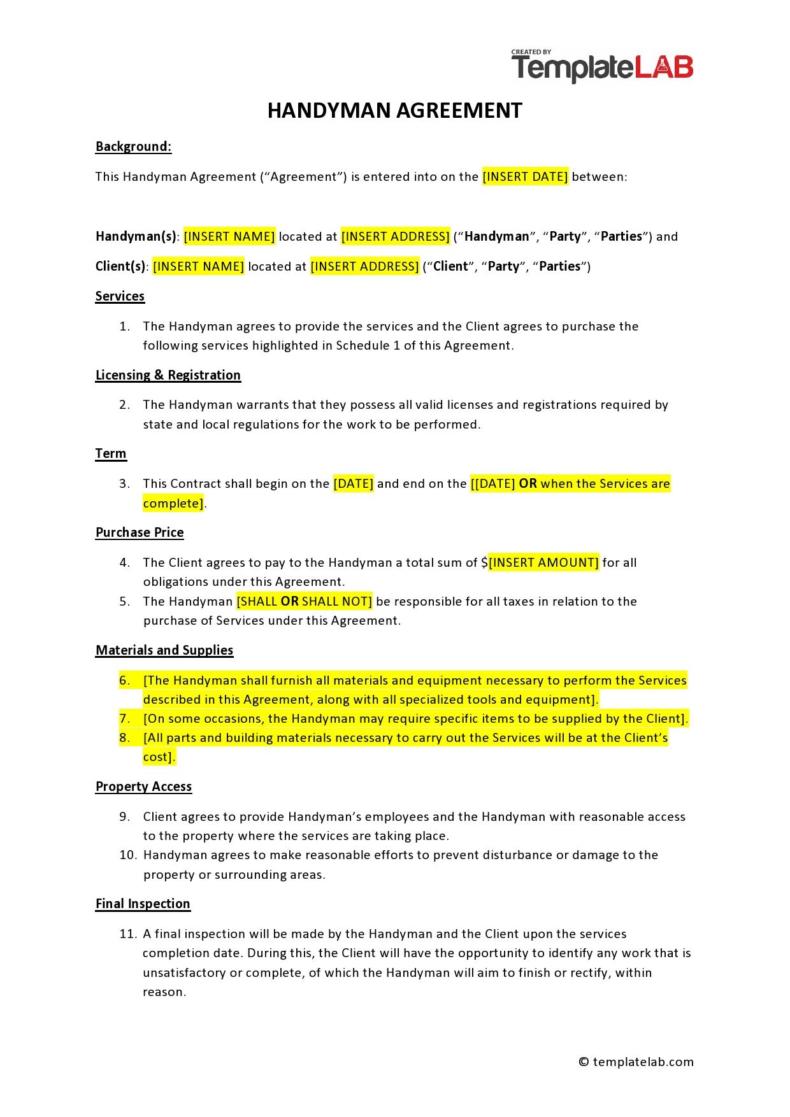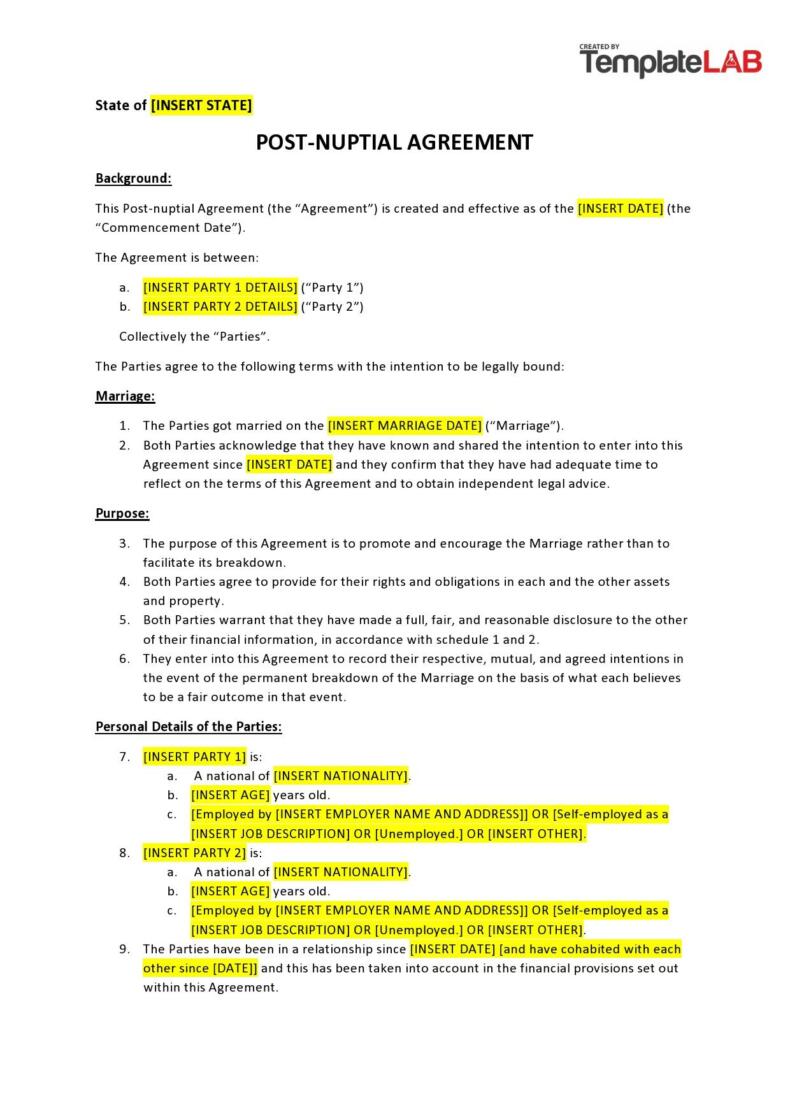Sometimes you can settle a divorce without having to go through the pain and bitterness between a husband and wife. This is usually the case when the divorce gets uncontested and the parties would amicably divide their property, debts, and assets accumulated during their marriage. The marital settlement agreement is a document that specifies the rights of both spouses then settles the issues of spousal alimony and child custody.
Table of Contents
- 1 Marital Settlement Agreements
- 2 What is a marital settlement agreement?
- 3 Marriage Settlement Agreements
- 4 Is a marital settlement agreement the same as a divorce decree?
- 5 Divorce Settlement Agreements
- 6 Is a marital settlement agreement binding?
- 7 Divorce Agreement Templates
- 8 How do I write a marital settlement agreement?
- 9 Marital Separation Agreements
- 10 Reaching and enforcing your agreement
Marital Settlement Agreements
What is a marital settlement agreement?
Reaching an amicable settlement with your spouse is the primary goal of a divorce and a marital settlement agreement can do just that. Written then signed by both the husband and wife, the contract specifies the terms of the divorce. Depending on what the issues are, such will and must get addressed.
The first and foremost issue that you need to address is the parenting and custody of children involved. You and the other parent must come to an agreement on the following issues:
- Whether you will legally share joint custody of the children.
- Designating the Parent of Primary Residence and the Parent of Alternate Residence.
- Including a regular schedule along with a schedule for vacations, holidays, and other breaks.
Having a marriage settlement agreement ensures each parent’s continued right to access health, school, and medical-related records. The divorce settlement agreement should also include provisions to assure each parent’s continued right to involvement in the children’s school functions and events. Moreover, you should address any other special issue or circumstance that involves the children.
Marriage Settlement Agreements
Is a marital settlement agreement the same as a divorce decree?
In the case of a marital settlement agreement, the husband and wife will split the agreed properties. The marriage settlement agreement lists both parties along with which of the properties each one gets to keep when the marriage comes to an end. Coming to an agreement about settlement is an essential step to the divorce but the sharing of property becomes official only when the judge signs off your case.
As is often the case, when a husband and wife have reached an agreement regarding the division of property, this ultimately gets included in the final divorce decree. But there still isn’t a guarantee that the judge handling the case will accept the division of property agreed upon by the two parties.
This is because the judge always has the final say when it comes to divorce. Once the divorce decree gets finalized, your marriage is then considered terminated. This final decree includes the final determination of how the marital property gets divided along with the list of responsibilities of both husband and wife after the dissolution of the marriage.
Divorce Settlement Agreements
Is a marital settlement agreement binding?
All agreements reached between the husband and wife during the divorce should get submitted to the court as formal order and stipulation, including the marital or divorce settlement agreement template itself. Upon approval by the court, these agreements become enforceable and legally binding between both parties.
Divorce Agreement Templates
How do I write a marital settlement agreement?
Divorce can be a really painful experience to get through, especially when it involves stress, heartbreak, and emotions. Part of a divorce proceeding is to create a marital or divorce agreement template. This is a legally binding document wherein you and your spouse agree to the terms of the divorce that covers a wide range of topics. Here are some pointers to guide you when creating your marriage settlement agreement:
- Begin with the basics
The first step is to obtain the required legal forms available from your courthouse’s law library or from your state’s or province’s government court of justice website. Like any other legal agreement, you must state the complete names of both parties involved in the agreement. - Include the relevant details
Provide all of the relevant information about your marriage like:
Your marriage date.
Your separation date.
The complete names and the ages of all minor children of your marriage.
The grounds of your divorce.
Your living arrangements and complete addresses of living in different houses. - Confirm the agreement
The next section contains the confirmation that you and your spouse have agreed to accept the terms of the divorce settlement agreement specified in the document. This acceptance, together with your witnessed signatures make the document legally binding. - Identify your debts and assets then divide them
The next section contains the terms on how you plan to divide the properties and debts. You may have “marital” or joint assets or debts and you may have “separate” or personal assets or debts.
In general, any property owed or owned by one spouse before the marriage remains their separate debt or asset and anything obtained during the marriage using marital funds falls under marital property even if only one spouse used them. Those subject to division in a divorce are only marital debts and assets. - Create a plan for parenting, visitation, and custody
You should already have a decision on whether sole, split or shared custody is ideal for the situation. Traditionally, the most common option is sole custody but there is an increasing trend today where divorce parents choose arrangements in which the children live with both parents or whatever works best for the family.
Should you opt for sole custody, you should specify what the visiting rights of the non-custodial parent are. Be as detailed as possible here like the days of the week, the start and end times of visitations, and holiday arrangements. These details reduce the risk of issues later on. - Include provisions for child support and alimony (spousal support)
The last to include are the terms and conditions of spousal and child support. Before anything else, keep in mind that you can’t sign away a child’s right to receive support although you can waive your own right if you want to.
Every state or province has its guidelines regarding support including listings on the minimum amounts payable. Moreover, if you can afford it, you can also include support for your child’s music lessons, orthodontics, summer camp, and the like. - Polish your agreement
Once you finish with the paperwork of your marital or divorce settlement agreement template, it’s time to review. Read your document over meticulously and look for omissions or errors. Make sure that it could be perfectly understood by anyone who reads it.
When an agreement contains too many mistakes, errors or typos, it can damage the credibility of your case and can lead to opportunities for misunderstanding. Let your family lawyer read it over before submitting the divorce agreement template to the court.
Marital Separation Agreements
Reaching and enforcing your agreement
Many divorcing couples reach an agreement regarding their divorce-related issues on their own. It can be as simple as an informal discussion over the dinner table. They can even become practical by writing their own marital statement arrangements. But it is still recommended for couples who have considerable assets and children to seek legal advice. For those couples who have little or no assets and no children, it would be okay for them to work everything out by themselves.
To reiterate, you may write their own marital settlement agreement with your spouse but if you don’t have the capability, you should hire your own lawyers – you cannot have the same lawyer. The lawyer should clearly explain your legal responsibilities and rights as related to the support and custody of your property, children, and alimony. As a couple, you will be in a better position to make informed divorce decisions if you have a clear understanding of your rights.
The lawyers can also take the lead part in creating, reviewing, and making revisions in the marriage settlement agreement while negotiating on behalf of each party if deemed necessary. To facilitate proceedings, it’s suggested to hire the services of a lawyer to ensure your agreement will hold in court.
Aside from hiring a lawyer, another choice you have is to hire a trained mediator, a third-party who can help you reach agreements during private, 3-way meetings. Although lawyers aren’t present during mediations, you can still ask legal advice from a lawyer who can also review the proposed agreements before affixing your signature on anything.
Whichever manner you reach your marriage settlement agreement, you and your spouse must sign it. Then you incorporate this document into your judgment of divorce so that the judge can review it then approve. Once the judge has had his final say, the terms of your agreement are already considered court orders that you must both obey.
You can enforce a marital settlement agreement by filing a formal motion or request with the court. This involves some paperwork. To have this enforced, you need to show to the court how your ex-spouse failed to follow the terms of your agreement. There are several reasons why you might need the court to help you enforce your agreement. Here are the most common ones:
- Your ex-spouse didn’t make spousal or child support payments.
- Your ex-spouse didn’t maintain dental, life or health insurance policies.
- Your ex-spouse didn’t pay for your children’s college education expenses.
- Your ex-spouse is in default on your mortgage payments.

